- Retour accueil
- Vous êtes ici : Blog Chemistry in Ancient Egypt The Great Pyramid of Khufu at Giza was a Cooling Unit Designed for the Purest Mineral form of Natron Manufacturing : the Salt Used for Pharaohs Mummification ©2021
The Great Pyramid of Khufu at Giza was a Cooling Unit Designed for the Purest Mineral form of Natron Manufacturing : the Salt Used for Pharaohs Mummification ©2021
Publié par Bruno Coursol dans Chemistry in Ancient Egypt le 20/02/2021 à 21:10

The Great Pyramid of Khufu at Giza was a cooling unit designed for the purest mineral form of natron manufacturing : the salt used by ancient Egyptians for Pharaohs Mummification.
The operating process of the "known" part of the Great Pyramid consist in creating evaporative cold inside the horizontal passage, using the power of water. For this, the "motor" is inside the grand gallery : the energy of an impactor; falling from the top of the gallery to the flooded ascending passage, is used to create a fog of micro-droplets of water that will initiate an adiabatic evaporative cooling effect in the horizontal passage. The cold is then stored inside the Queen's chamber and (most probably) transferred to a sodium carbonate and sodium bicarbonate manufacturing unit installed on the flat roof of the pyramid (Solvay-like process).
Very quick abstract of the study
Ancient Egyptian pharaohs used chemistry and physics to legitimate themselves as kings of Egypt, and they forged an entire religion for that matter : gods were self-glorification metaphors of their scientific accomplishments. The end game of this technological program was the Great Pyramid of Giza where evaporative cooling was engineered in the known part of the pyramid, using the power of water, most probably as suggested by the strong ammonia smell in the Red Pyramid, to cool down chemical manufacturing of sodium carbonate and sodium bicarbonate. At that time, sodium carbonate was called natron, and it was the salt used for the mummification of the pharaohs.
Ancient Egyptians were the first civilization to master a Solvay-like process for sodium carbonate manufacturing, long before it got reinvented in the 1800's in Europe. The key elements of that process is the temperature control of the chemical reactions (the cooling), and the dome shaped plate necessary for the counterflow chemical reactions to occur in an efficient way, and that plate is precisely what is the disc of Sabu.
If mastering the Solvay-process was important, it actually looks like the cold was the most magical phenomenon worshiped by ancient Egyptians, as suggested by Akhenaten and Nefertiti who represented themselves as Shu and Tefnut, the deities that combined together were creating the evaporative cold (Shu = dry warm air, and Tefnut = spat water).
Also, the very first pyramid complex, the Step Pyramid of Djoser, was called "the refreshment of the Gods".
Last updates on the Lady of the Well Taweret block, the wedging Bes block, the meaning of the Was Scepter.. : click on "LE BLOG" button.
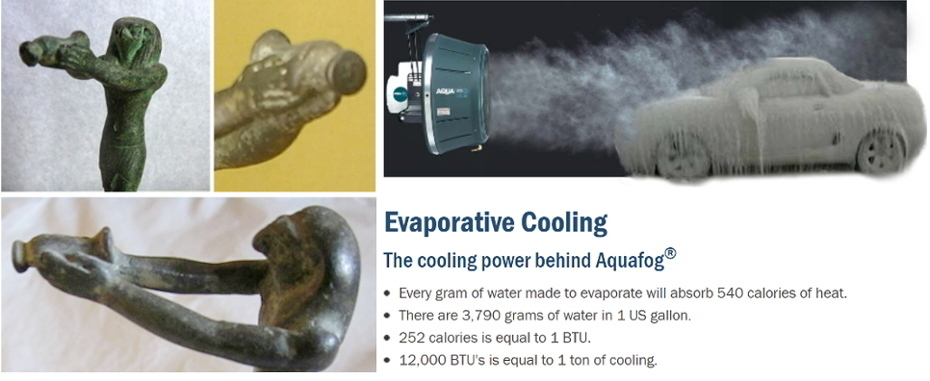
The ancient Egyptian god Horus, holding the fog nozzle of the evaporative cooling passage of the Great Pyramid.
Horus images : E3752 from the Louvre Museum and figurine of Horus DUT162 also from the Louvre Museum ; Paris, France, Hauteur : 9 cm ; Largeur : 2,7 cm ; Profondeur : 6 cm. Date de création/fabrication : Basse Epoque (664 - 332 BCE).
Evaporative cooling applications webpage screenshot : AquaFog® from Jaybird Manufacturing Inc (Pennsylvania, USA).
The surprising efficiency of the evaporative cooling process that created cold in the horizontal passage of the Great Pyramid of Khufu, is still used today in modern evaporative coolers
"Evaporative coolers lower the temperature of air using the principle of evaporative cooling, unlike typical air conditioning systems which use vapor-compression refrigeration or absorption refrigeration. Evaporative cooling is the conversion of liquid water into vapor using the thermal energy in the air, resulting in a lower air temperature." Source : Wikipedia
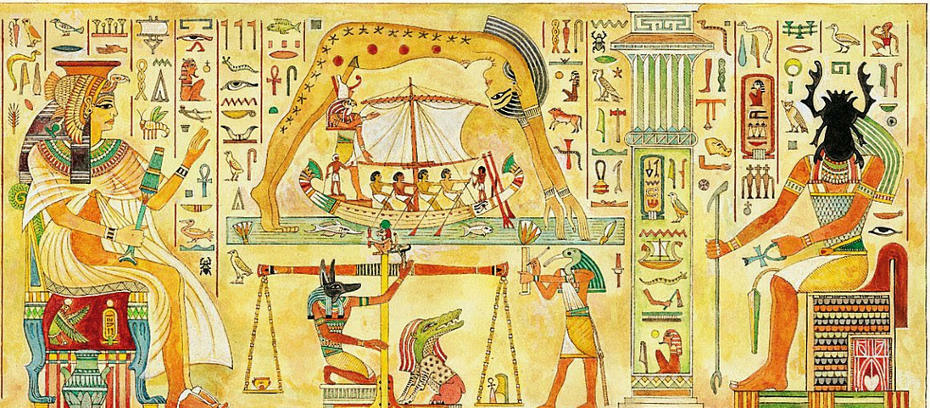
On this scene representing Nut, water is here clearly represented. In the same scene below, water is not represented, but it is though suggested by the solar boats, the fisherman, the fishing net and the postures of Geb and Nut. Goddess of the sky Nut is clearly diving into the water. Geb is not represented because he is the water. Shu is also not represented because he is the sail of the boat.
The link between the water of the Nile (Hapi) and the Dendera Light womb of Nut : Geb, the "god of the earth"
"Hapi (Ancient Egyptian: ḥʿpy) was the god of the annual flooding of the Nile in ancient Egyptian religion. […] Hapi was not regarded as the god of the Nile itself but of the inundation event. He was also considered a "friend of Geb", the Egyptian god of the earth." https://en.wikipedia.org/wiki/Hapi_(Nile_god)
In my opinion, Geb is actually a lot more than just a friend, because Geb, as Hapi and Nut, is all about water.
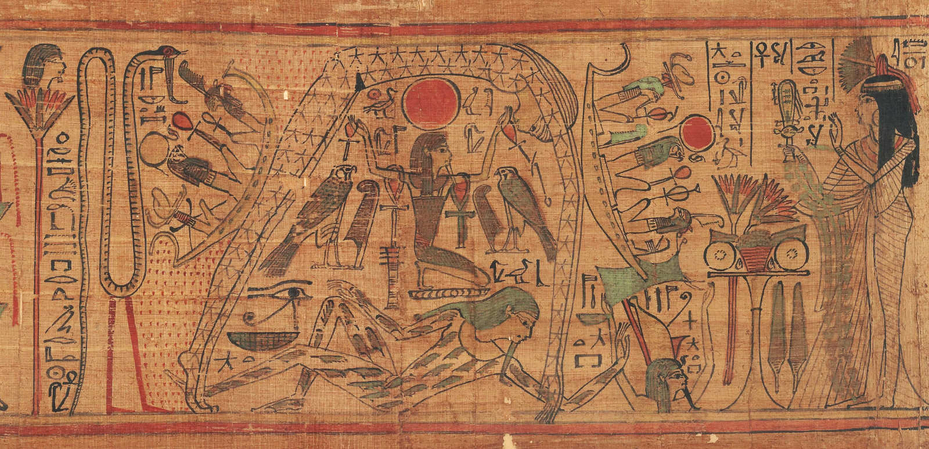
Papyrus mythologique de Tanytamon, Egyptien 172. Bibliothèque nationale de France, département des manuscrits (color and luminosity modified on gimp) : https://gallica.bnf.fr/ark:/12148/btv1b8304598h
Shu is not separating Geb from Nut, Shu is holding Nut in the air : Shu is absorbing moisture and accumulating humidity
In my opinion, that scene of Geb and Nut separated from each other by Shu is actually representing the cycle of water between its liquid form and its evaporated form.
Nut is getting out of the water (her lower body) and then comes back in with her upper body.
So why Nut is described as the goddess of the sky and Geb as the god of the earth ?
We've just seen that Nut and Geb were both representing water, but in two different forms : liquid water (Geb) and evaporated water (Nut). Once you take the water out of the equation, the only elements remaining is the earth (where the liquid water is) and the sky (where humidity and moisture are).
This is why today, egyptologists say that Geb is the god of the earth and Nut the goddess of the sky.
They are just missing the water.
Why nobody is describing the relation of Nut with water despite her water-pot emblem and the name similarity with Tefnut ?
I think the reason is that nobody really wants to talk about the water. It is that simple. But if you do that, not only you can't understand the Dendera Light, but you can't understand "god of the earth" Geb either.
For egyptologists, water doesn't deserve to be studied for anything else but agriculture, even though the expression "the power of water" appears in many occasions in the Book of the Dead, as well as the one we've just seen : "the protective magical energy in liquid form" about the Dendera Light.
If you don't think about water in the famous Geb and Nut paintings where Shu is represented "separating" them both, you can't understand their respective postures.
If you do think about water you understand that :
1 • Geb is swimming : Geb is a representation of liquid water (on earth) = god of the water on earth
2 • Nut is diving into the water from the air : Nut is a representation of humidity / moisture = goddess of water in the sky
3 • Shu (god of dry warm air and fog) is the one receiving / holding / sustaining / supporting that humidity and he is the one separating them both
In short, the Geb and Nut scene is all about the evaporative process that is the motor of the evaporative cooling

No one ever questioned the fact that Nut, the "goddess of the sky" had a water-pot emblem ?
According to Wikipedia's page on Tefnut, 'tfn' means 'to spit : "Literally translating as "That Water",[2] the name Tefnut has been linked to the verb 'tfn' meaning 'to spit'[3] and versions of the creation myth say that Ra (or Atum) spat her out and her name was written as a mouth spitting in late texts [4]". Source : https://en.wikipedia.org/wiki/Tefnut
But according to https://en.wiktionary.org/wiki/tfn, 'tfn' means orphan : "Conventional anglicization: tefen. orphan".
The correct translation for 'to spit' would be 'tf' and not 'tfn' : "Etymology 2 : (intransitive) to spit (+ m: to spit (something) out) [Pyramid Texts, rarely later]". https://en.wiktionary.org/wiki/tf
Tefnut = 'to spit' + Nut. It means that Nut is referring to water
If Wiktionary is right over Wikipedia, that means that Tefnut, 'tfnwt' is 'tf' + 'nwt' = to spit + 'nwt'
If Tefnut means "that water" and is referring to spat water, then Nut 'nwt' is referring to water itself. Hence the water-pot emblem of goddess Nut.
The theoretical evaporative process of the cold production
What is remarkable with the Geb and Nut scene, is that it is a representation of the evaporative process that is producing the cold inside the Great Pyramid.
We've already seen in the first post about the Dendera Light (June 5th 2021), that ancient Egyptians loved to show and explain what they were doing, in their own way of course : they've represented a snake spitting out its venom on one side of a relief, and just next to it, they've represented the Dendera Light with the same snake inside the bulb, and by doing so they were saying that the Dendera Light was created by the venom of the snake, as a metaphor of the spat water getting out of the fog nozzle, under pressure and in the form of microdroplets.
The sociological modern drama interpretation of Geb and Nut
"There is speculation between Shu and Geb and who was the first god-king of Egypt. The story of how Shu, Geb, and Nut were separated in order to create the cosmos is now being interpreted in more human terms; exposing the hostility and sexual jealousy. Between the father-son jealousy and Shu rebelling against the divine order, Geb challenges Shu's leadership. Geb takes Shu's wife, Tefnut, as his chief queen, separating Shu from his sister-wife. Just as Shu had previously done to him." https://en.wikipedia.org/wiki/Nut_(goddess)
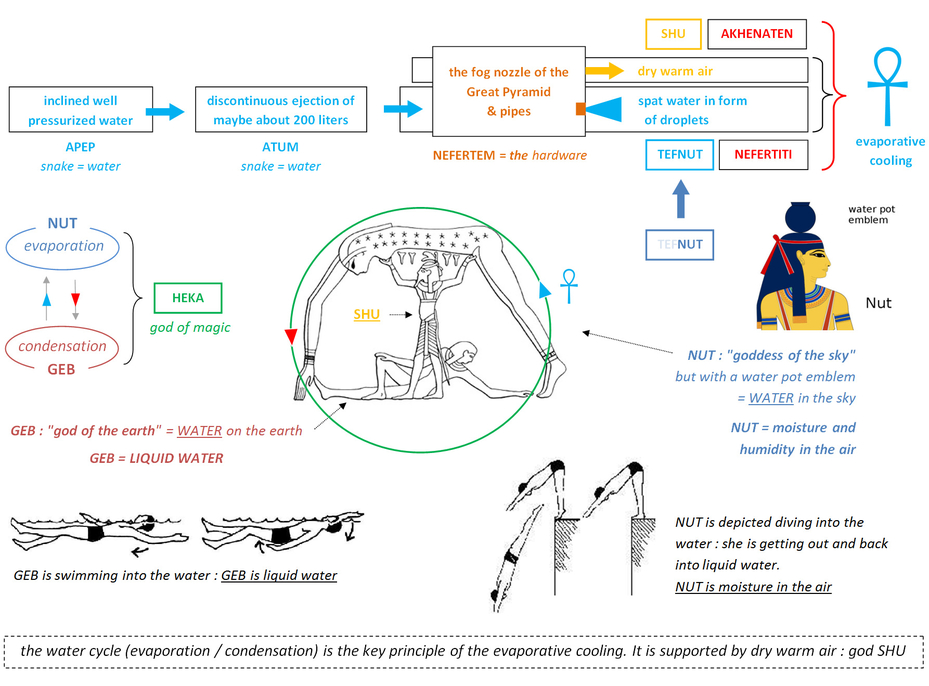
The water cycle of the evaporative cooling
Not only ancient Egyptians represented the creation of the evaporative cooling in the famous Dendera Light reliefs in the Hathor temple, but they also represented the theoretical part of the process in the famous scene showing Geb, Nut and Shu.
This scene is reproducing the water cycle from its liquid form (GEB) to its evaporated form (NUT) that is sustained by the dry warm air (SHU).
The first steps in deciphering the Great Pyramid of Giza
When I started to work on the pyramid, like everybody, I have focused myself on the 3 key elements that are the grand gallery and the 2 ascending and horizontal passages.
The problem with the grand gallery, is that you can do pretty much whatever you want with it. There are no clues here to start.
But with the 2 passageways, things are different.
I first worked on the horizontal passage. Because we can find a lot of clues here. And every one of them is pointing into the same direction, the same goal : to deal with the effect of thermal stress (expansion joints, small blocks, sand behind the stones). Another clue is that all these elements are only found in the beginning of the passage, close to the gallery and the ascending passage.
It means that the thermal stress only occurred in that specific area.
The ascending passage was also easy to figure out. Because of the girdle stones and the polygonal interlocking way the blocks were assembled. It meant that for this passage, the stress on the structure wasn't about temperature changes but pressure and shocks. Another clue is the granite stone blocks, the granite plugs.
If we look closely to these stones, the 2 at the bottom look like they've never moved an inch, and it is true for the lowest of them : the granite plug #1 didn't move at all since it had been put in place. The second one did move a bit, but only for a few meters at much, as this granite plug #2 was the shock absorbing block for the Taweret temporary sealing block of the well, granite plug #3, when it had been decided to shut down the pyramid and drain the well of its water.
That Taweret block, is really different from the other ones, and it really looks worn out, like it had a really busy day.
To be honest, it took me some time to understand the all thing. The ascending passage was clearly under water : it was a well and it had to sustain a lot of pressure, coming from the inside of the well itself. The girdle stones are the ones telling us this part : they are huge blocks and the well is entirely passing through them. The girdle stones are nothing else than belts around the well, they are forming a complete strapping of the well.
And what could have cause this increase of pressure inside the well if not the fall of an impactor of some kind?
Then, we know what was the purpose of the grand gallery : pull up that impactor to the upper part of the gallery, and let it go and crash into the well.
Maybe every 15 to 20 minutes the impactor entered into the well, and the water inside got pressurized and a small amount of it got ejected towards the horizontal passage. Once inside the passage, the water was then used to cool the air the same way we cool down the air today with an evaporative cooler, working on the adiabatic evaporative cooling process : the liquid water transforms itself in vapor by absorbing the energy of the air ; as a result, that air is then cooled down by the process.
The cooling just happened every 15 to 20 minutes and was located at the real beginning of the passage. That was why they had to deal with the thermal stress of the structure, the temperature was changing all the time. And we are not talking here about just a little cool down : when the air is very dry, its capacity to absorb humidity is really high and the evaporative cooling is very efficient : it can result into a 15 to 20°C drop in temperature (please, see the Carrier diagram, further below).
In my opinion, the final temperature inside the Queen's chamber, could have been as low as 5°C to 10°C, (41°F to 50°F).
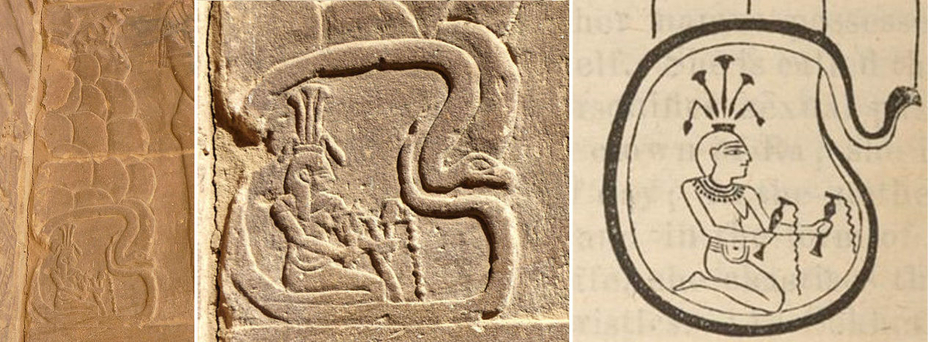
Isis temple, North wall of the Gate of Hadrian with a representation of the Nile god Hapi, crouched in his cave and surrounded by a serpent, Philae, Egypt : https://fr.wikipedia.org/wiki/Fichier:Hapy_Philae.JPG and http://www.temples-egypte.net/philae/hadrien/paroiNord/registreMilieu.html#B1
[Snake = Water] 1 • Hapi in his cavern creating the very first snake out of water
On the left image above (from the Philae temple), Hapi (in his cavern) is depicted creating the very first snake that referred directly to the Great Pyramid. As seen in the previous post, that cavern is a representation of the King's chamber, the main water tank of the pyramid. The fact that Hapi was the god of the annual flood of the Nile, indicates that the water used in the pyramid was coming from the Nile : it wasn't rain water like a first thought it was. It also mean that the pyramid could only have been operated during the flood season.
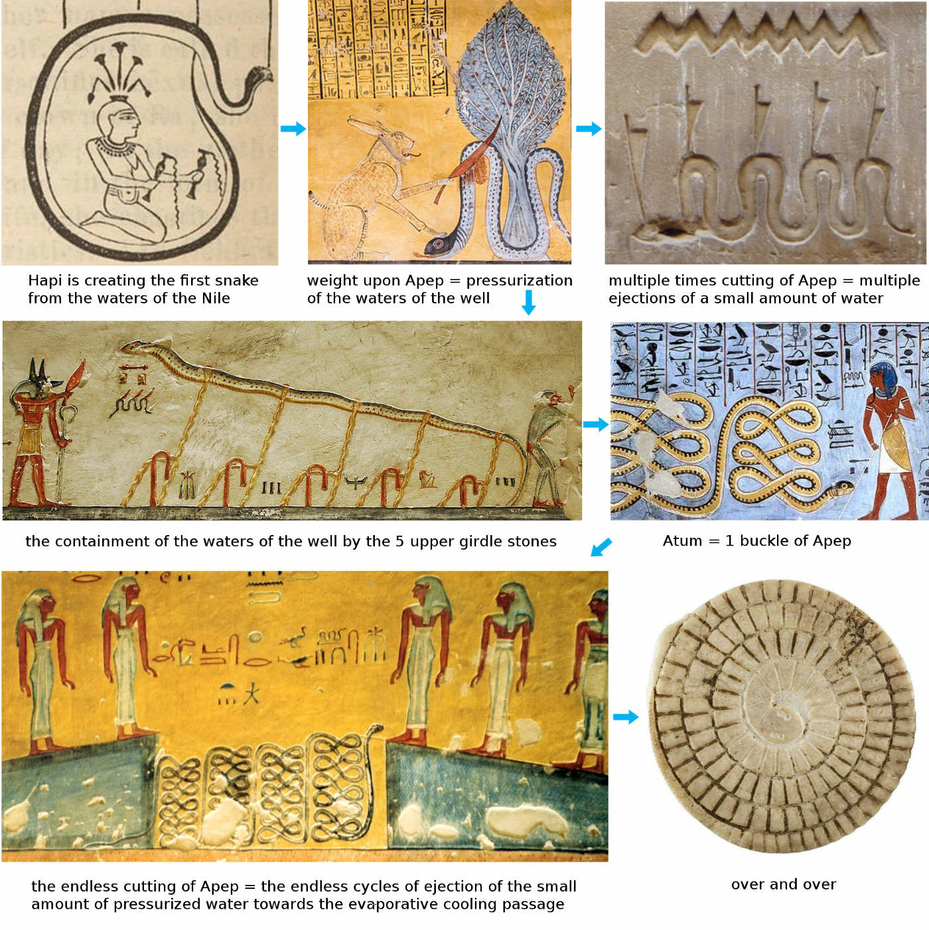
[Snake = Water] 2 • Snake representations of ancient Egyptian gods are about water
One of the most recurrent appearances in ancient Egyptian religion is about snakes : they include the snake in the Hapi's cavern, the great serpent god of the Underworld Apep (Apophis) and the most important of all : Atum.
All these snake gods are metaphors of the water used to "power up" the Great Pyramid of Giza.
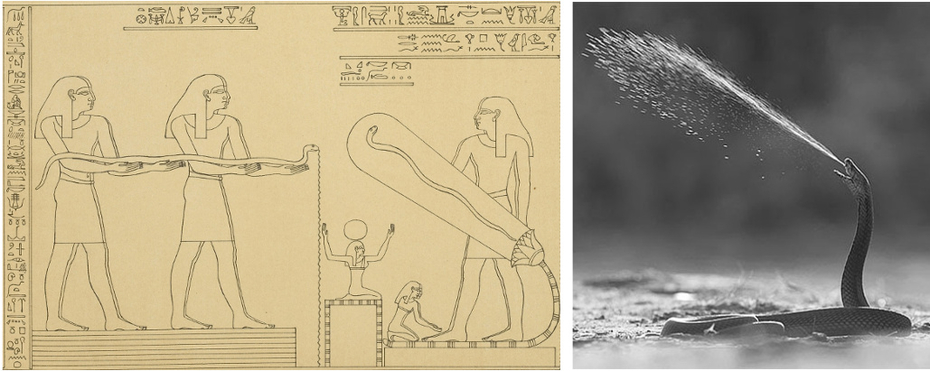
The microdroplets fog mentioned in my theory is the famous Dendera Light Bulb. The Dendera Light reliefs are depicting how ancient Egyptians produced the cold (the spat venom of the snake of the reliefs), and that they used this cold to cool down Solvay-like towers for the natron manufacturing (the djed pillars of the reliefs). They even represented how the cold was transferred from the chamber to the tower : by the Queen's chamber shafts (the arms of the reliefs).
The double outline of the characters producing / offering the bulb light (or the snake), is the proof that it was cold production : they were having cold themselves.
Please read the Dendera Light post for all the details
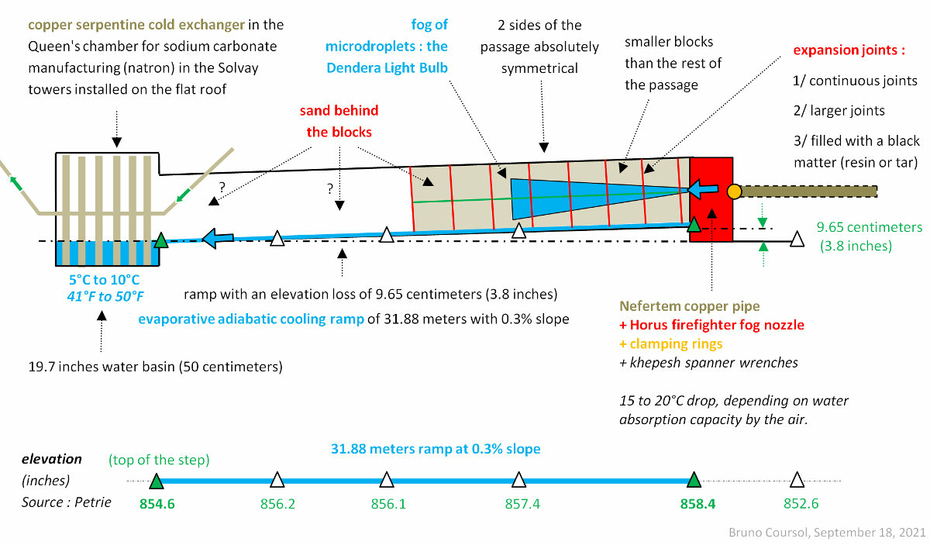
The Great Pyramid of Khufu horizontal evaporative cooling passage. Elevation data (inches) : "The pyramids and temples of Gizeh", by Petrie, W. M. Flinders (William Matthew Flinders), Sir, 1853-1942 ; section 40 (page 66) : "Passage to Queen's Chamber"
Everything in the first part of the horizontal passage of the Great Pyramid is designed to reduce the stresses on the superstructure induced by multiple temperature variation cycles. It is difficult to say how long was the cycle, but let's say it was about 15 to 20 minutes. It means that during all this time, the first part of the passage had plenty of time to warm up back to the temperature of the grand gallery. And every 15 to 20 minutes, it was cooled down again. The problem is not the cooling down, but the endless cycle of cooling down and warming up again. That is what stresses the structure.
1/ The first clue : the horizontal passage
That clue, came from what we call today the horizontal passage. But actually, it is really not that horizontal at all. Inside this passage is a portion that is actually a ramp, a 32 meters long ramp with a 0,3% slope. And that puzzled me, because what the heck right. A ramp here?
And that ramp was not the only weird thing about it. There was, on the first half of the passage, many troubling things :
1/ the blocks were very small, and that is completely uncommon in all the pyramid, because it is the worst thing to do if in a "common structural sense" : you need to get every block resting on top of two different ones to maximize the strength of the structure. In that first part of the passage, every single block is perfectly fitted on top of another one, forming a continuous joint between them.
2/ These joints were not only continuous but also larger, and filled with a strange black filling resembling to resin or tar.
3/ Each side of the passage here, were also perfectly symmetrical to one another.
4/ Behind these blocks, we also discovered there was some sand.
That's a lot of uncommon things, and suddenly, I got it. Because, when you add up the fact that a few feet away you have the grand gallery, and just above of it something that is nothing else than a big water tank, and that is the King's chamber, you have water in mind now.
When I was younger, I used to have an air cooler, the one you just have to put water in it to get fresh air. And that was what this passage was all about. The slope was intended to get water flowing, very slowly, and evaporate itself. Because when the water transforms from liquid to gas, it does cool the air. It is actually called an air adiabatic cooling system. It doesn't cost a thing, and can be very effective when the air at the beginning of the process is very hot, and very dry (and that part is gonna be very important soon).
So know, we understand why we have so many oddities in the first part of the passage. This first half is where most of the cooling was taking place if we make some air coming from the very beginning of the passage. The joints, were expansion joints (large and continuous). The sand was here to absorb any expansion and distortion forces. The blocks were small because less susceptible to crack.
And at the end of the passage, we have a 50 cm step (that's a big step). But in fact that step is nothing else than a basin, for the water.
This water was here to accumulate and store the cold that was produced in this passage. Probably this basin was in fact covered with a wood casing, so it was perfectly waterproof.
This horizontal passage was designed to do 2 things : cool down the water temperature in the basin and let the air coming from the grand gallery, passing through the passage.
Because under the niche of the Queen's chamber was an air vent going to the subterranean complex allowing fresh air and cold water to flow to the complex.
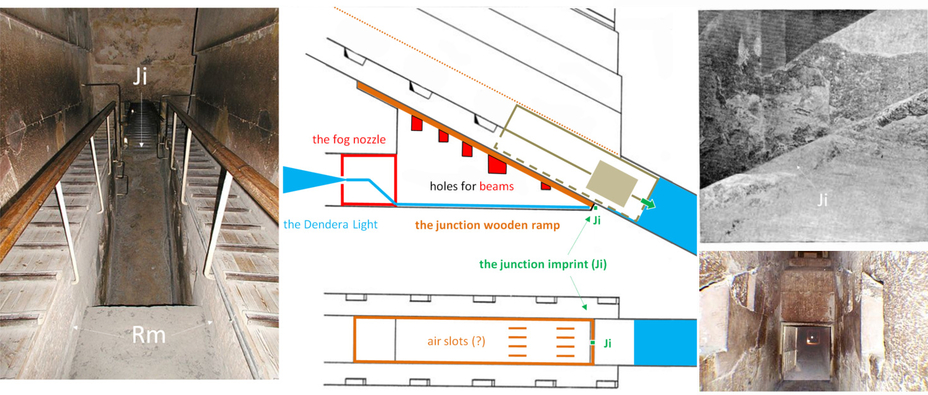
On the above image of the Great Pyramid Grand Gallery lower end, the opposite 5 pairs of holes in which the junction wooden ramp would have been set onto massive wooden beams are clearly visible, as well as the markings made by the ramp itself (Rm). On this picture though, the junction imprint (Ji) in the middle of the cut-off isn't visible.
The junction Grand Gallery / inclined well / horizontal cooling passage of the Great Pyramid
On the first above image, what is amazing to notice is that the modern layout that have been designed for the tourists to walk on the lateral ramps, is actually exactly reproducing the original design made by the ancient Egyptian themselves so they could operate the 2 hauling beetles.
It is true for the "modern walking trail" on the floor, and it is also most probably true for the safety rails. If you look closely at these rails, they perfectly fit with the height of the ascending passage ceiling.
On this particular image, it is then pretty easy to imagine the (most probable) fixed caisson in which the impactor was moving : just imagine that the safety rails are completely wooden boards covered both on the sides and on top of them, and you have the fixed wooden caisson.
The junction wooden ramp : structural continuity but with water (and probably also air) exchanges towards the cooling passage
The junction wooden ramp would have ensure the structural continuity between the Grand Gallery and the inclined well, while the junction imprint would have allow the pressurized water to get out of the well.
The wooden ramp would have been supported by massive beams set in the 5 pairs of very impressive opposite holes in the walls of the junction area.
If the fixed caisson really existed, when the impactor would have moved inside, air would have been pushed in front of it and would have been redirected to the cooling passage to renew the air and get rid of the humidity without being forced into the well itself. Humidity is the evaporated water that resulted from the evaporative cooling process.
The ramp couldn't be in solid rock because they had to bring in all the equipment of the Queen's chamber and the fog nozzle, and because they needed to get it out after the shutdown procedure; but also because they most probably had to regularly get in the horizontal passage to check, clean and repair these same equipments.
The recovery of the impactor
Was the wooden cradle float efficient enough to make the impactor really floats at the surface of the inclined well waters or was it only floating in mid-water, I couldn't say. Maybe the goal was only to avoid the impactor to hit the Taweret block that was the bottom of the well.
If a fixed wooden caisson was implemented, they first had to open a small section of it at the bottom of the gallery so that they could reattach the impactor to the central rope before it could be moved back to the top of the gallery.

The use of wet sand as thermal insulation, in the construction of cool chambers. Left : Construction of Zero Energy Cool Chamber at Thoubal district, Manipur (India). Right : same thing but at Karong Village.
The Zero Energy cool chamber sand of the horizontal passage of the Great Pyramid of Khufu
The idea that the horizontal passage of the Great Pyramid was designed as a part of a cooling unit, is reinforced by the fact that fine sand was found behind some blocks of the passage.
If my theory is right, then that same sand would have been probably set all around the entire structure [horizontal passage + Queen's chamber] ; exactly like it is shown on the above photographs of the construction of Zero Energy Cool Chambers, in India.
After all, when the French team who discovered the sand behind the blocks, reported it, they were asked to stop their work. We don't know the entire extend of the sand casing behind the blocks.
I first thought the sand was here to reduce the thermal stress on the structure, due to the constant sudden changes in temperature that occurred in the first part of the passage, and maybe it also served this problem ; but it was most likely to be essentially a thermal insulation.
The Dormion and Goidin discovery on the fine sand lining of the horizontal passage of the Great Pyramid
Excerpt from the Los Angeles Times article "Scientists Seeking Hidden Vaults in Great Pyramid Find Only Sand", written by Michael Ross, September 1986 : https://www.latimes.com/archives/la-xpm-1986-09-09-mn-12810-story.html

"A team of French scientists searching for hidden, treasure-filled rooms in the Great Pyramid of Cheops suspended work Monday after drilling three holes through an interior wall and finding only sand. But the French team and the head of the Egyptian organization supervising the work said they believe that the presence of a powder-fine lining of sand between the interior stones of the Great Pyramid supports their theory that secret chambers lie deep within the 4,600-year-old tomb of the Pharaoh Cheops.
“The sand means the ancient Egyptians are protecting something, something very serious and meaningful,” said Ahmed Kadry, head of the Egyptian Antiquities Organization. He said that although the French team failed to find and penetrate the cavities, samples taken from the wall beyond the sand lining indicate that it is made of a fine, soft limestone used by the ancient Egyptians for ornamental carvings on royal tombs.
“We can be sure now that there are cavities, and not just structural or stress cavities but something much more mysterious,” he said.
The French mission, headed by Gilles Dormion and Jean-Patrice Goidin, two architects who postulated the existence of secret rooms in the Great Pyramid on the basis of architectural anomalies in the interior stonework, had hoped to bore four holes through the wall of a gallery leading to the so-called Queen’s chamber. The plan then was to observe and photograph the interior with an endoscope, an optical instrument developed for viewing the interior of human organs.
However, the work was suspended after five days when, after boring three holes through more than eight feet of hard limestone, the drills hit the fine sand lining. Jacques Montlucon, an engineer with the French National Electric Company, which is providing technical expertise for the project, said the work was suspended because the drills being used are not suitable to bore through sand.
The existence of hidden chambers in the Great Pyramid has long been suspected, but there was never any real evidence until last May, when the French found what they said appeared to be three spaces, measuring 6 feet by 9 feet, off of the Queen’s gallery. The discovery, which the French said could indicate the presence of hidden storerooms, created a flurry of excitement among Egyptologists, who for the most part have assumed that all the treasures of Cheops were plundered long ago.
Not all the experts share Kadry’s conviction that there are secret chambers, but discovery of a sand lining about 10 to 17 inches thick between the great stones is regarded as a puzzling and exciting find in itself."
The Carrier diagram, or "Carrier psychometric chart", is used for determining the temperature and humidity properties of a constant pressure air-water mixture.
The dryer the air is at the beginning of the cooling process, the greater amount of water it would be able to take, and the colder it is gonna get. For example, if you have an air at 10% humidity and you know you can get to 90% humidity, then the temperature can be cooled down from 25°C, to 11,5°C.
More details on the temperature necessary to cool down the Solvay towers for the sodium carbonate manufacturing (natron), on the Dendera post.

The key element of the connection between the grand gallery, the inclined well and the horizontal passage.
This photograph was taken before 1910, and it is the only photograph I know that shows this part of the lower end of the grand gallery. In the foreground there is the beginning of the horizontal passage (the Queen's chamber would be on the right), then you have the abrupt cut-off of the smooth ramp sloping floor and the slot in the middle. In the background, there is the east ramp and the north wall of the gallery.
The "slot" in the middle of the cut-off, is not the result of an abrasion, but a real design made for a unique reason : it allows the connection between the well and the horizontal passage when the well is lined up with its wooden casing.
This layout is absolutely essential to the process and it was probably extended by a heavy wooden piece that would sustain the pressure coming from the well and let the air, and then the pressurized water coming through towards the unit that made the micro-droplets.
The forced ventilation is primarily intended to clear the air of the subterranean chamber where the work on the cement is done, and the cold water would be used to realize the experimental reconstructed stones.
The air is first cooled down at the exit of the micro-droplets unit and is immediately used to cool down the water that runs on the 32 meters ramp that ends up in the basin of the Queen's chamber where it would be even more cooled down by the copper serpentine cold exchanger.

2/ The second clue is the polygonal arrangement of the blocks of the ascending passage.
These blocks are displaying an interlocking layout revealing that the passage was also under a lot of longitudinal forces. If the girdle stones were set to counteract transversal forces passing through the ascending passage (from the inside to the outside of the well), the interlocking layout of the blocks reveals that the passage was also under strong longitudinal forces (from the top to the bottom of the well, and reverse).

3/ The third clue are the girdle stones : the ascending passage was an inclined flooded well
When you look attentively to the drawing of the Edgar brothers, showing the girdle imprints on the walls, floor and ceiling of the passage, you can see something absolutely amazing : these girdle stones were arranged in 2 sets of girdles, and that these 2 sets were positioned at a different angle to the vertical axis.
It is like the 2 sets of blocks are opening up to reveal a dormant breach. More amazing is that at the exact location where the breach is positioned, we can find a tiny squared imprint in the floor with a granite plug stuck inside !
Contrary to what seems to suggest all the ascending passage drawings mentioning the girdle stones, there is not just 3 or 4 of these huge blocks in the passage. Actually, the entire passage, from the G4 girdle (the lower of the usual girdles) to the lower part of the passage, is nothing else than 100% girdle stones. The fact is that when the Edgar brothers tried to understand the role of these girdle blocks, they couldn't make any sense of this lower part of the passage and all these girdles. They were only interested in finding distances between blocks in order to associate these distances to Bible or other historical events. Girdle stones from G5 to G14 are completely pressed against each other. They couldn't measure anything so they didn't talk about it (this is precisely what they wrote themselves), and they didn't draw them either. And since, everybody did the exact same thing.
In italic, are excerpts from "Great Pyramid Passages, Volume 1, by John and Morton Edgar 1910", sections 460 to 470.
Source : https://archive.org/details/GreatPyramidPassagesVol11910Edition/page/n239/mode/2up
Section 462, talking about the girdle stones : "Before leaving home we had recognized the importance of the three upper ones as marking important dates in the Law Dispensation".
Section 467 : "Those Girdles which lie lower down the passage than the three just described, are all in contact with one another".
Section 468 : "it would seem that the stones which form the Girdles here were originally built in solid, end to end, after which the bore of the passage was cut through them. Above the fourth Girdle, however, there can be no doubt that the passage was constructed in the usual way, i.e., that the floor was first laid, the walls erected at the proper distance apart on the floor, and the roof- stones then placed on top of the wall-stones".
The problem is that this part of the passage, from G4 to G14 is so more protected with these girdles, that it makes the usual ones look like insignificant.
If you want to understand the girdle stones layout, you need to understand that the passage was flooded and that the girdles were acting as an integrated strapping of the well.
The pressure inside the well was probably perfectly distributed on all its surface by a another complete wooden casing, that also allows the well to be waterproof. It is possible though, that the seal between the blocks was sufficient enough so that no casing was needed. Probably the center part of the floor casing part is thinner than the rest of it, and it makes a kind of gutter inside the casing allowing air and water to get out of the well, into the entry of the horizontal cooling passage.

The lower end-to-end girdles are arranged in 2 sets with different orientations
When you look attentively to the drawing of the Edgar brothers (plate CXXVIII), showing the girdle imprints on the floor of the passage (red and green short lines), you can see something absolutely amazing : these girdle stones were arranged in 2 sets of girdles, and that these 2 sets were positioned at a different angle to the vertical axis.
This particular layout reveals a dormant breach, just waiting to be opened up, and it is located right where the Al Ma'mun cavity has been digged.
The breach opening for the shutdown procedure of the pyramid
The 2 sets of girdles with different orientations are opening up to reveal a dormant breach. More amazing is that at the exact location where the breach is positioned, we can find a tiny squared imprint in the floor with a granite plug still stuck inside, and on the other side of the wall is the huge Al-Ma'mun cavity, leading to the subterranean part of the Great Pyramid.
My guess is that this particular layout was designed to drain the well for the shutdown procedure of the pyramid : a small granite block would have been positioned in the small imprint (colored in blue on the drawing), placed against the wall, directly next to the dormant breach.
This is Petrie talking about the part just ahead (south) of the granite plugs : "The present top one is not the original end ; it is roughly broken, and there is a bit of granite still cemented to the floor some way farther South of it". Source : The Pyramids and Temples of Gizeh par W. M. Flinders Petrie. Chapter : Ascending Passage, page 21.
When time has come to shut the pyramid down, the impactor is lifted up to the top of the grand gallery one last time, unless this time there is no float anymore. When the impactor is released and enter the inclined well, it doesn't pop back up to the surface but sink to the bottom of the well with high velocity. When it hits the granite plug block n°3 that was dormant all along by this small granite block in the imprint, it opens the breach and all the water is drained trough the cavity of Al-Ma'mun.
The draining of the well was necessary in order to empty completely the pyramid of all its content. More about it farther below, same post (dormant breach, little imprint, draining of the well into the cavity of Al-Ma'mun...).
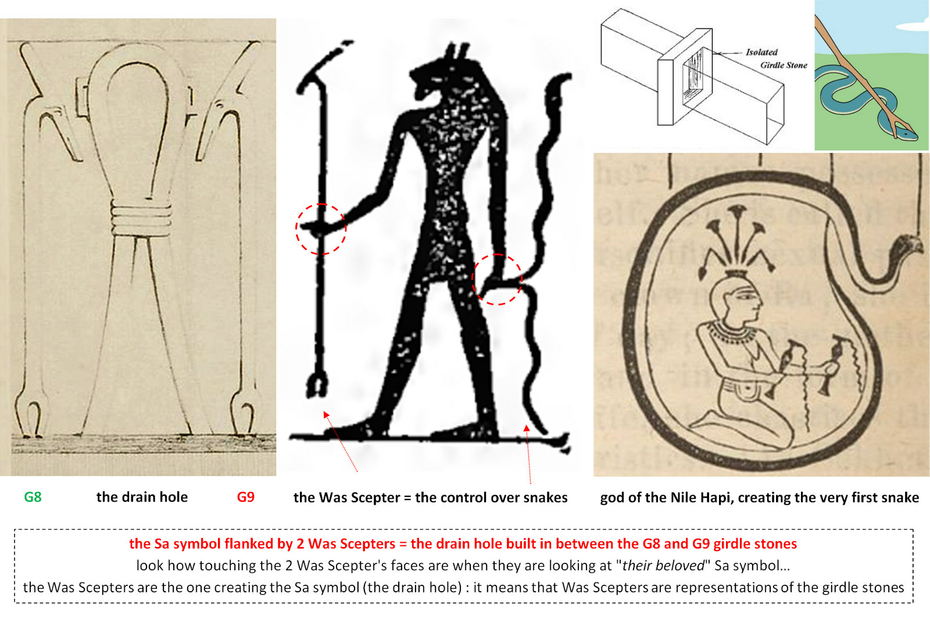
Was Scepters and Sa symbol, from the Hatshepsut’s birth scene, Edouard Naville "The Temple of Deir el Bahari" (London, 1896), vol. 2, pl. 50. Image courtesy of the University Library Heidelberg : The Ebony shrine, northern half of the middle platform.
https://digi.ub.uni-heidelberg.de/diglit/naville1896bd2/0050
Draw of a relief on the North wall of the Gate of Hadrian with a representation of the Nile god Hapi, crouched in his cave and surrounded by a serpent, Isis temple at Philae, Egypt : https://fr.wikipedia.org/wiki/Fichier:Hapy_Philae.JPG
How to Catch a Snake : https://www.wikihow.com/Catch-a-Snake
[Was Scepter] • Dominion over water : the Was Scepters are representations of the Girdle Stones
The Hatshepsut’s birth scene relief turns out to be a real gold mine, because not only we can validate the Bes and Taweret interpretation, as well as the understanding of the Sa symbol, but we can also decipher another symbol from this relief : the Was Scepter.
On the left side of the Bes and Taweret scene, we can see the Sa symbol flanked by 2 Was Scepters. These scepters are not randomly positioned : they are both turning their faces towards the Sa symbol. They are flanking the Sa symbol and looking right to it like it was their baby. Don't you think the Was Scepters have a very touching/loving/amusing kind of look, facing the Sa symbol ?
Well, I do, and I also think that somehow, the Sa symbol really is their little baby !
We've just seen that the Sa symbol was a representation of the drain hole of the well, and we also know that this drain hole was set in between 2 particular girdle stones : G8 and G9 (more information on that matter, on previous posts).
What it means is that the Was Scepters are representations of the girdle stones.
And it makes perfect sense. We know that snakes were representations of the water used to power up the Great Pyramid, so what better way of representing the control over that water, than by the control over snakes.
If Was Scepters are very much looking exactly like snake handling tongs, it is because they really are snake tongs. Except of course these snake tongs are actually metaphors.
Ancient Egyptians didn't want to talk about the control they had over snakes, but over the "magical" pressurized water of the well : they wanted to talk about the containment of the waters of the well.
This idea of having power over snakes that would be associated with the Was Scepter, is exactly what is saying the second above image. Both hands are doing the same thing : the firm grip on snakes (control over snakes) on one hand is equal to the Was Scepter hold in the other hand.
Also, from Wikipedia's page on the Was Scepter : "Was sceptres were used as symbols of power or dominion, and were associated with ancient Egyptian deities such as Set or Anubis as well as with the pharaoh. Was sceptres also represent the Set animal. In later use, it was a symbol of control over the force of chaos that Set represented."
These "forces of chaos" are the pressurized waters of the well.
More on the Was Scepter in the post about Bes
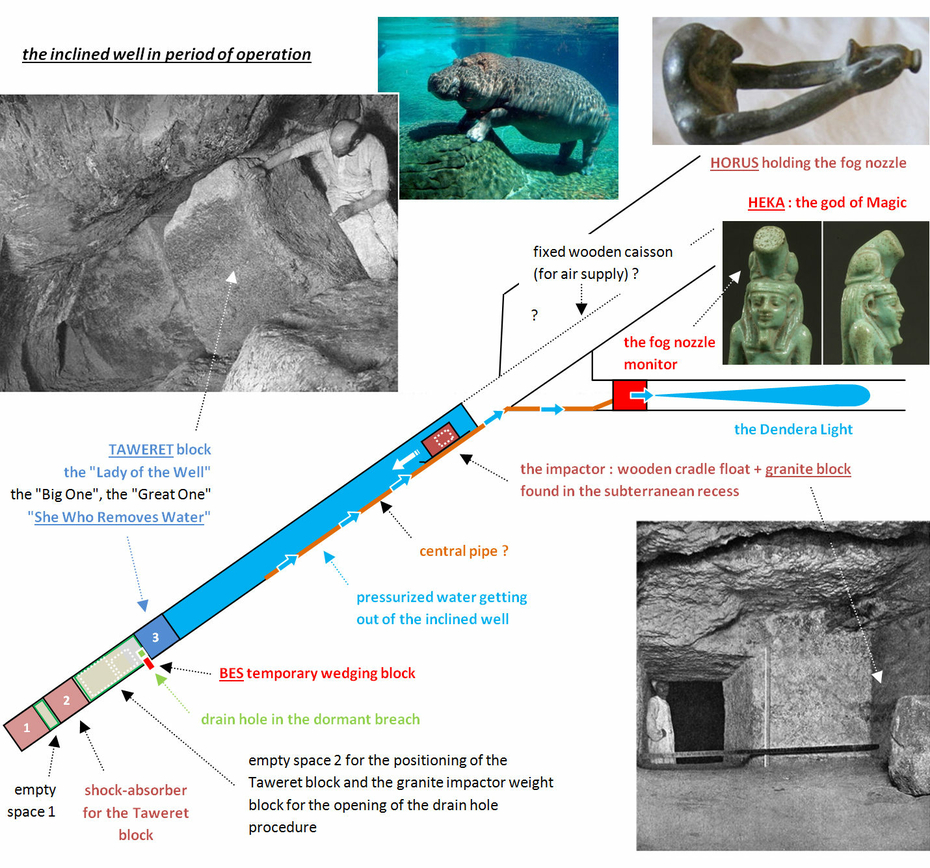
The 14 girdle stones of the Great Pyramid of Khufu, indicating that the ascending passageway was a well, and that it was drained inside the Al-Ma'mun cavity towards the descending passageway and the subterranean chamber.
My guess is that this particular layout was designed to drain the well for the shutdown procedure of the pyramid : a small granite block would have been positioned in the small imprint, placed against the wall, directly next to the dormant breach. When time has come to shut the pyramid down, the granite block n°3 is lifted up to the top of the grand gallery one last time, unless this time there is no float anymore. When the block is released and enter the inclined well, it doesn't pop back up to the surface but sink to the bottom of the well with high velocity. When it hits the small block in the imprint, it reveals the breach and all the water is drained trough the cavity of Al-Ma'mun.

Why goddess Taweret is represented as an hippopotamus
When the Great Pyramid was operational and the ascending passage flooded to form an inclined well, in the continuation of the Grand Gallery's central gutter, the upper granite plug was sealing the well.
Consequently, this sealing block would have been permanently underwater : it explains why ancient Egyptians chose to personify this block into the hippopotamus : a huge semiaquatic animal that loves to stay, walk and even sleep completely submerged underwater.

Image of the All Blacks, performing the "Kapa o Pango" (a pre-match haka) at the rugby world cup 2011 New Zealand / Argentina, thanks to Jean-Francois Beausejour : https://commons.wikimedia.org/wiki/File:Rugby_world_cup_2011_NEW_ZEALAND_ARGENTINA_(7309674588).jpg
[Bes] 1 • Bes' posture and the Māori ceremonial dance Haka
This is certainly not by accident that there is a perfect match between Bes's posture and the attitude of rugby players performing the famous Māori ceremonial dance Haka.
Both Bes and the Haka performers are saying the exact same thing : "you will not pass through me, I won't move."
The thing is that the posture similarity is not the only one : even the stories sound familiar.
Ancient Egyptians were engineers, transforming (hot) warm and dry air into cold air. That was the all point of the known part of the Great Pyramid : creating cold air for "sun god Ra".
Everything on BES and Maori modern Haka performances by rugby players : here
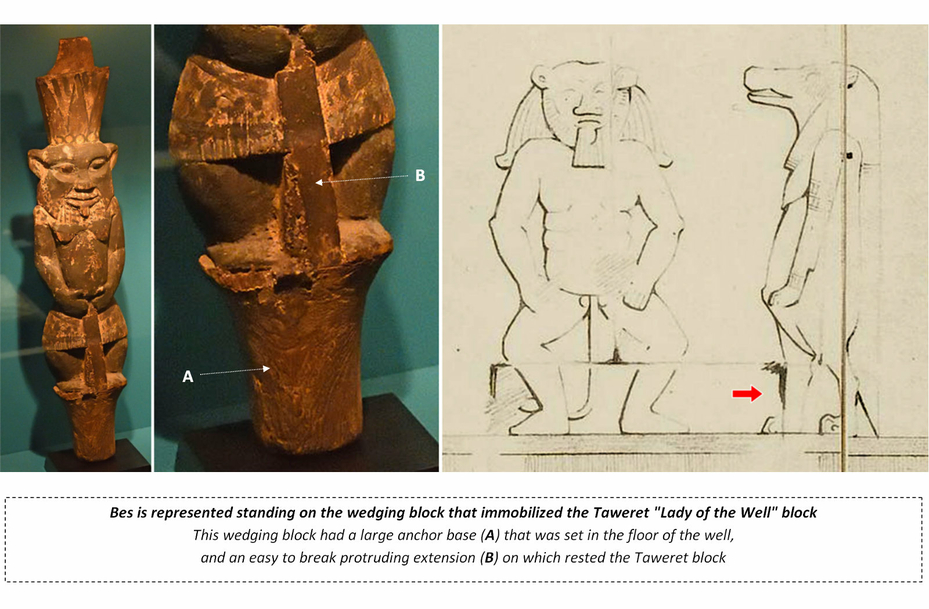
On this incredible picture, the wedging block is actually represented twice : not only we have the original design of the real block, but we have also its metaphorical representation in the god Bes. Image courtesy of Dosseman, from Two Bes-shaped legs for a bed, wood, New Kingdom : https://commons.wikimedia.org/wiki/File:Allard_Pierson_Museum_Bes_Legs_for_bed_7603.jpg
[Bes] 2 • The actual original design of the wedging block
More than just being able to validate the couple Taweret/Bes as the 2 blocks sealing the inclined well, we can do even better and have a pretty good idea of the real design of the Bes wedging block, thanks to the "Two Bes-shaped legs for a bed", at the Allard Pierson Museum and Knowledge Institute in Amsterdam, Netherlands.
As I have already said, the simple solution that I came up with, is most certainly wrong or at least incomplete.
The major problem is that the little imprint in the floor of the well between G8 and G9 is located against the West wall. If my idea was correct, this imprint would have been located right in the middle of the width of the well, so that there wouldn't have been any force applied against the wall.
Obviously, something is missing, and the wedging block was only part of the solution, but at least, we can start with something and we now also have what is most probably very close to the real original design of that wedging block : a very large base (A) that would have anchored the block into the floor of the well, and a very fragile protruding upper part (B), that was immobilizing the Taweret block, but which was also ready and easy to break on demand.
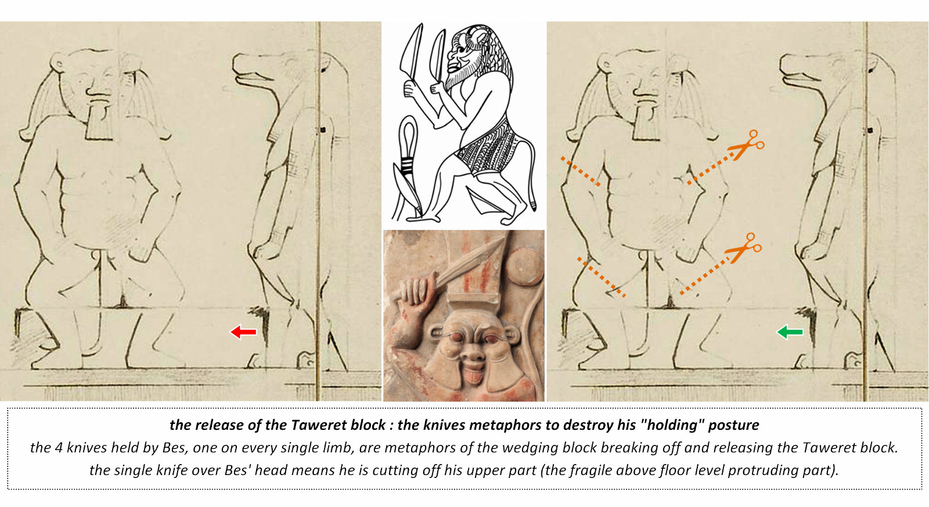
[Bes] 3 • The breaking off of the wedging block and the release of the Taweret sealing block. Knives = Cut, Break
This is breathtaking to think that during the entire operating of the Great Pyramid, the Taweret block was actually only maintained in position by a temporary wedging block (first above image). Its release is what is depicted on the center images.
Like in other occasions, ancient Egyptians used many different ways of depicting this release :
In the lower center image, we have Bes holding the knife over its head to represent the fact that the fragile upper part of the temporary wedging block had to be broken off : the metaphor is directly referring to the original wedging block. In other words, by lifting up the knife over his head, Bes isn't trying to cut the plumes of his headdress, he is just cutting off his upper part.
But on the upper center image, the metaphor is much more elaborate : it’s a metaphor on another metaphor. Bes is the metaphor of the wedging block, and by cutting off every single arm and leg, the other metaphor is that he isn't able to hold Taweret anymore. The most important thing about Bes is his "holding" posture with strong arms and legs, but if you take these elements out of the way, if you cut out his limbs, there is no "holding" posture possible anymore : the Taweret block is then released.
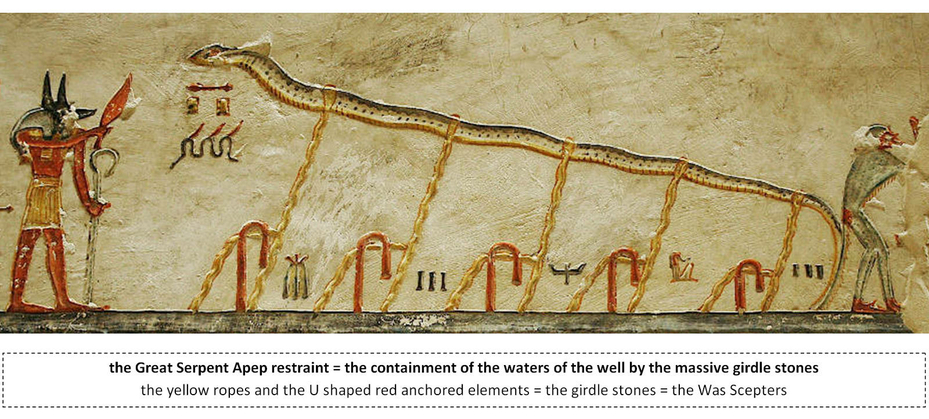
The restraining of Apep in the above relief from Ramesses KV19 tomb, is another representation of the containment of the inclined well pressurized waters. Once pressurized and contained into the well, a small amount of the "powered" waters can be redirected towards the evaporative cooling passage.
The restraining of Apep : the containment of the inclined well pressurized waters
We've seen that the Great Serpent Apep was a metaphor of the inclined well waters and that the fall of the impactor into the well pressurized it. The forces at play were so high that not only it was at the origin of some of the more impressive parts of the fights between Ra and Apep (the thunder noises, the rumble and trembling, etc.), but it also put the well on tremendous structural forces. That was the mission of the girdle stones : maintain the structural integrity of the well.
So, when we are looking at the restraint of the Great Serpent Apep, on the above image from Ramesses KV19 tomb, we are looking at the representation of the water that was restraint inside the well. The ropes are representations of the restraint, and the red elements in a inverted U shape, are the girdle stones : the upper girdles are actually 2 U-shaped half girdles stacked on top of each other.
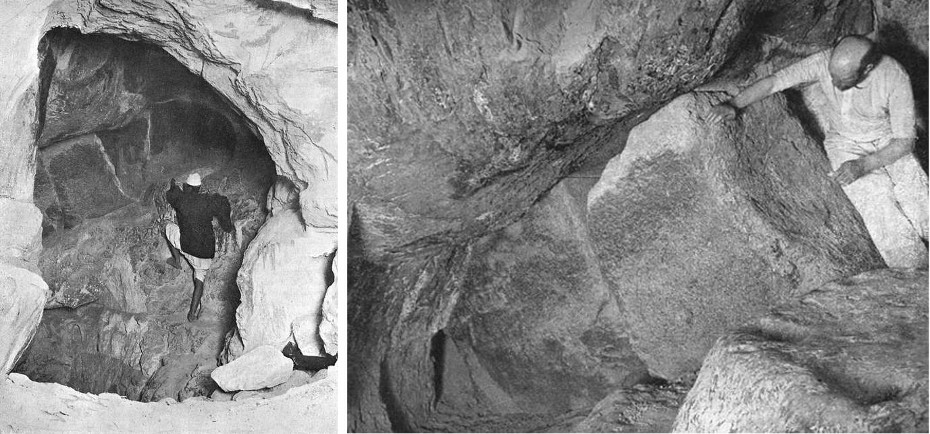
On the left is the cavity of the Caliph Al-Ma'mun, in which the water of the inclined well (the ascending passage of the Great Pyramid of Khufu) was drained into. The upper granite plug has been deified into goddess Taweret : "the Lady of the Well", the "Big One", the "Great One" and "the One Who Releases Water".
4/ The Grand Gallery : the heart of the living pyramid
The way cold was produced into the horizontal cooling passage, is absolutely marvelous, really. Hear me out.
That part is actually a very tricky one. Because it requires 3 parts, and one of this part is moving constantly from one to the other one. And because one of them is in the air, and the other one is filled with water.
The first part is the grand gallery; and the third part is an impactor that consist in the assembly of a granite block, most probably the one found in the subterranean recess, and a wooden float. The goal was to have an impactor with sufficient weight, but that would have been easy enough to get back from the waters of the well, without sinking completely to the bottom of the well. That block was first moved up, from the lower part of the gallery to the higher part, and then it was simply released in the central part of the gallery, the gutter.
That gutter was completely covered with a wood casing, all the way down the gallery, and it extended into the inclined well (the ascending passage), so that a continuity was created between the gallery and the inclined well.
In the hypothesis that the impactor was moving inside a fixed casing, when the block went down the gallery, it first pushed all the air contained inside this casing in front of it, that would be about 56 m³ of air that was then forced into the horizontal passage. This supply of the evaporative cooling passage, would have clean the air and removed the humidity that was resulting of the evaporative process.
Once the impactor hits the water of the well, this water get pressurized and some of it is ejected towards the entry of the cooling passage. But
Because pressurized water alone is not efficient enough to get a perfect vaporization of the liquid water into evaporated water, they had to transform it into microdroplets. There are actually many ways of doing it : you can project the water onto something (a simple needle for example) or into something (like a low-pressure spiral nozzle which has a very large opening so there can't be any clogging happening), but like I said before, they surely used a multi-needles nozzle.
So now, we have everything we need to evaporate the liquid water into vapor for the air to cool down.
Of course, when the impactor hits the water, the shock wave could have very much so damaged the well. That is why, all the way down to the bottom of the well, it is reinforced by 14 massive blocks : the girdle stones. These stones are so big that the well passes inside them, completely trough them, and they are designed to work exactly like a belt, or a metal ring you have on a wine barrel.
There is a precision to make here : because of the comprehension of the Taweret goddess and the Bes deity, respectively metaphorical representations of the granite plug #3 that sealed the bottom of the well, and of the wedging block that immobilized the Taweret block, all the lower girdles were only here so that the draining of the well would be successful. The lower part of the (dry) part of the well, hid the apparatus that would allow the well to drain. For that, the Taweret block imperatively had to slide from its starting position to the position it has now, and this lower part of the passage had to be so solid that nothing would have move an inch.
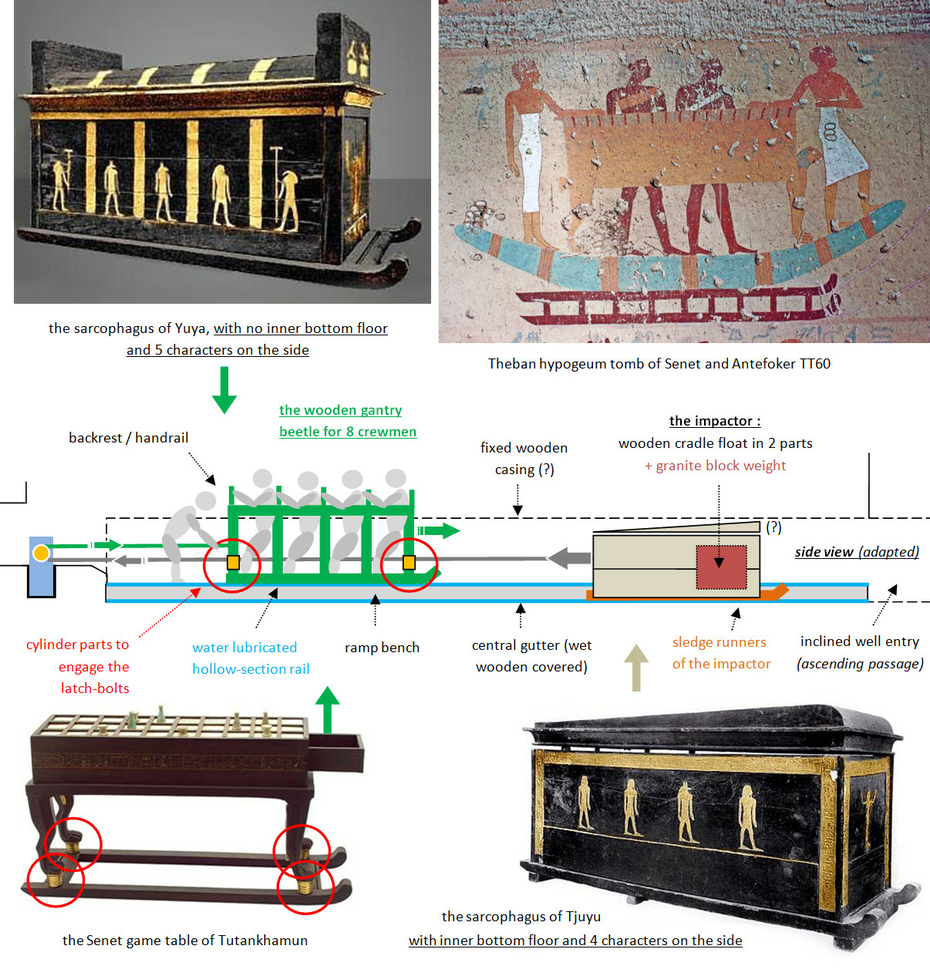
The speed of the impactor
Also, we need to talk about the "spoiler like" design of the top part of the sarcophagus of Tjuyu. Until now, I didn't try to evaluate the maximum speed gained by the impactor in its descent towards the inclined well, but maybe we should, because maybe this "spoiler like" part is really a spoiler.
With absolutely no evidence at all, let's say with pure instinct, I'd say that the maximum speed of the impactor would have been maybe close to 60 or 65 km/h, but again, this is only guesswork (that would be around 40 miles per hour).

Ptah-Sokar-Osiris figure from the Louvre in Paris (top right image), Numéro principal : N 3512. Source : https://collections.louvre.fr/en/ark:/53355/cl010018325
The Sokar latch bolt representations
Left image from Kairoinfo4U from the tomb of Irynefer TT 290 at Deir el-Medina. The squatting falcon Sokar is a metaphoric representation of the latch bolts of the Grand Gallery : the cow Hathor looks like it is gonna run over the falcon, exactly like the towing scarab would do on the latch bolts. Source : https://www.flickr.com/photos/manna4u/11433106165
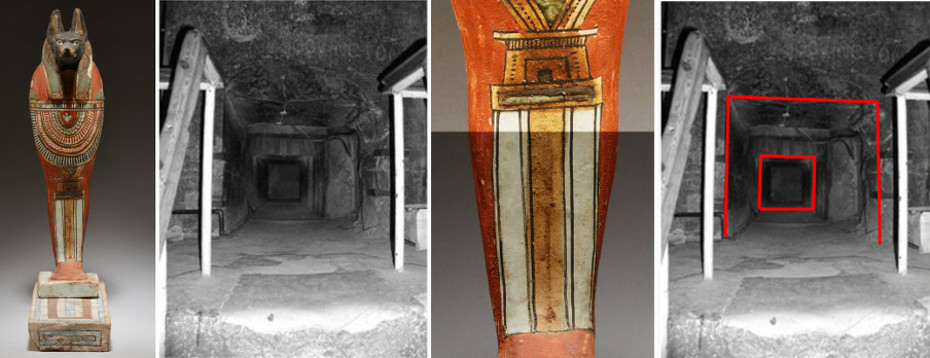
Image on the left and center : Funerary Figure of Duamutef. 400–30 B.C. Late Period–Ptolemaic Period. The Metropolitan Museum of Art, New-York. On view at The Met Fifth Avenue in Gallery 133.
The Grand Gallery layout replica of the Sons of Horus figures at the Metropolitan
The first photograph is one of the Four Sons of Horus figures, visible at the Metropolitan Museum of Art at New-York, and is showing a jackal-headed figure representing Duamutef, the god who protected the stomach of the mummies.
The half lower part of this image has been magnified and partially enlightened on the second picture of the figurine so that we can see clearly the different structures depicted.
My assumption is that what we have here is a complete representation of the grand gallery layout of the Great Pyramid of Khufu :
1/ The eastern and western ramps, with 2 hollow section rails by ramp
2/ The central gutter (painted here in yellow, but in blue in the Catawiki figure, above)
3/ The top platform, with what could be the axle beam for operating the 3 ropes
4/ The south wall of the grand gallery
5/ The opening of the antechamber (black line)
6/ The opening of the passage to the King's chamber (black square)
Please note that the 2 ramps are showing the same double lines as the ones found on the squared scarab amulet that we can see below. It would reinforce the idea that the wooden beetle was in fact a double beetle.

Funerary Figures of the Four Sons of Horus, with Imsety (human head) second from the left. 400–30 B.C. Late Period–Ptolemaic Period. The Metropolitan Museum of Art, New-York. Imsety is the only one with a human head, the three other Sons of Horus figures have heads representing a jackal (god Duamutef), a baboon (god Hapy) and a falcon (god Qebehsenuef).
The axle beam for operating the 3 ropes of the gallery, was inserted into the 2 holes of the platform
The second magnified image is from the figurine of Imsety, the god that protected the liver, and who was one of the Four Sons of Horus. This image shows the eastern and western holes of the platform and it also depicts that the axle beam ends were having tenons that would fit inside these holes.
If this draw of the platform is to be taken literally, that means that the main axle beam was placed onto that platform and that my first idea that it could have been situated further into the passage to the antechamber was wrong.
The Four Sons of Horus real meaning : the scarab team
Inside the grand gallery of the Great Pyramid, it was not 1, but 2 beetle scarabs that were operated. The question of knowing if they would be physically connected or not, is not so easy to answer, but I think they were.
Anyway, many or most of representations of scarab amulets, are showing 4 or 8 elements, and I think that the Four Sons of Horus are representing the team of the scarab beetle unit. That is the reason why the complete layout of the grand gallery is depicted on these Four Sons of Horus figures visible at the Metropolitan Museum.
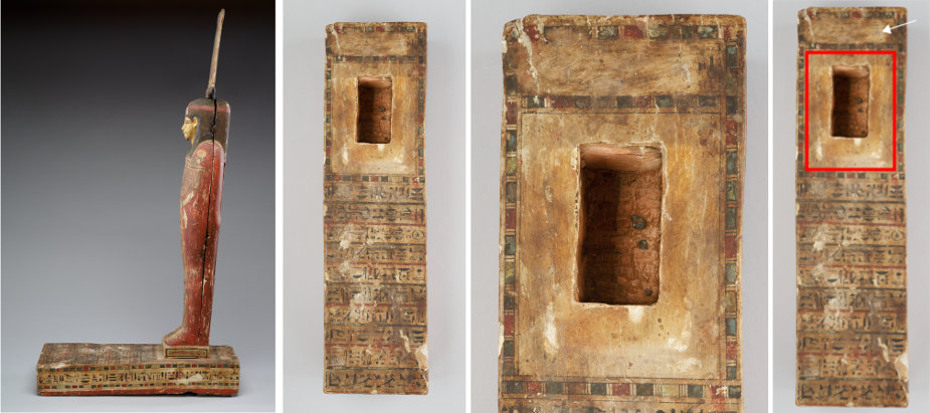
The rectangular shape empty of any decoration on the base of the Ptah-Sokar-Osiris figurine (highlighted in red), indicates where was inserted the granite weight that transformed the caisson into a piston/impactor, that was projected inside the inclined well of the Great Pyramid of Khufu. The white arrow shows the area that was protecting the caisson from the impact with the water of the well (the ascending passage).
Photograph credit : Ptah-Sokar-Osiris Figure, 306–30 B.C. Metropolitan Museum of Art, New-York. On view at The Met Fifth Avenue.
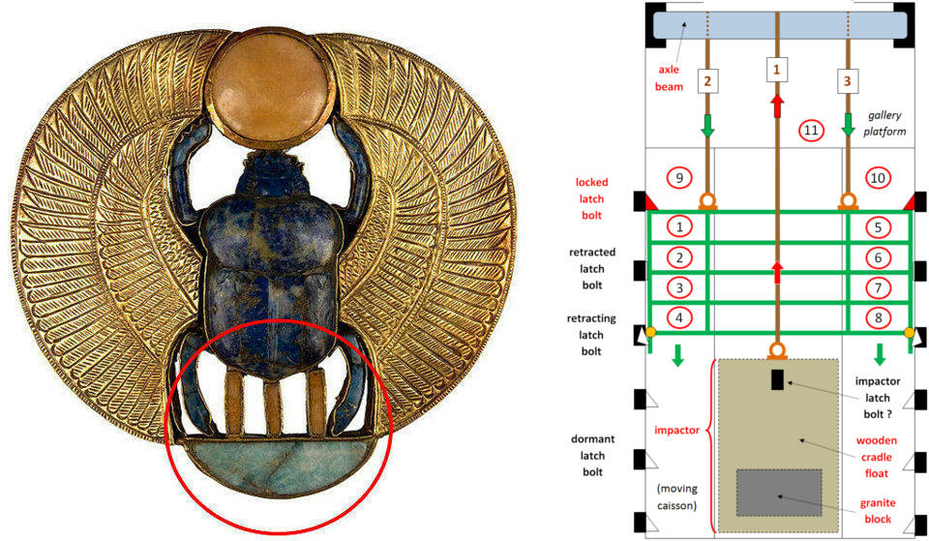
The equipment inside the grand gallery : the scarab beetle
A wooden gantry, that I call "the beetle", was operated by 10 men on the ramps. 8 were inside the beetle and 2 were "flying crewmembers", operating behind the beetle progression (these men were in charge of forcing the latch-bolts inside the walls after the passage of the beetle, and they were responsible for inserting the security pins inside the long mortises when the beetle was lifted up).
More details about the beetle on the scarab amulet post, here
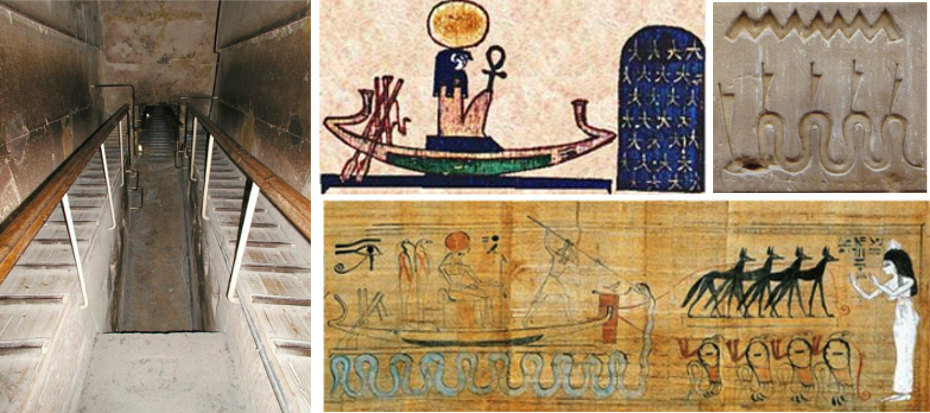
Left : Great Pyramid of Khufu at Giza, entry to the the ascending passage (inclined well), viewed from the grand gallery. Top and center : Egyptian god Ra in his solar barque, by Ausir. Top right : wall relief of Apep, temple of Edfu (author : Rémih, on Wikipedia). Bottom right image from Wikimedia Commons, author : Soutekh67
The Apep myth is the representation of the inclined well operating
The key element of the evaporative cold production was the ascending passage : it was flooded and every 15 to 20 minutes, its waters were pressurized by the fall of the impactor, operated from the grand gallery. Every time it got pressurized, a small amount of its waters were ejected into the horizontal passage where the fog nozzle(s) was (were) set to create the fog of microdroplets that would evaporate and cool the air.
This sequential events are actually metaphorically depicted in the myth about Apep and its endless fights with Ra. For more on this part, please visit its dedicated post
The snake symbolism and the fog nozzle
In previous posts, I have suggested 2 possibilities for the nature of the fogging nozzle that ancient Egyptians could have chosen to produce the microdroplets fog into the horizontal passage of the Great Pyramid, using the inclined well pressurized water : a spiral nozzle and an external needle. But I think they used another option.
We have already seen that the snake was the symbol of the microdroplets fog production, because of the way that the snake is projecting its venom when protecting itself.
So, if they would have wanted to depict that fogging nozzle, it would have been associated with the snake.
And that is precisely what they did.
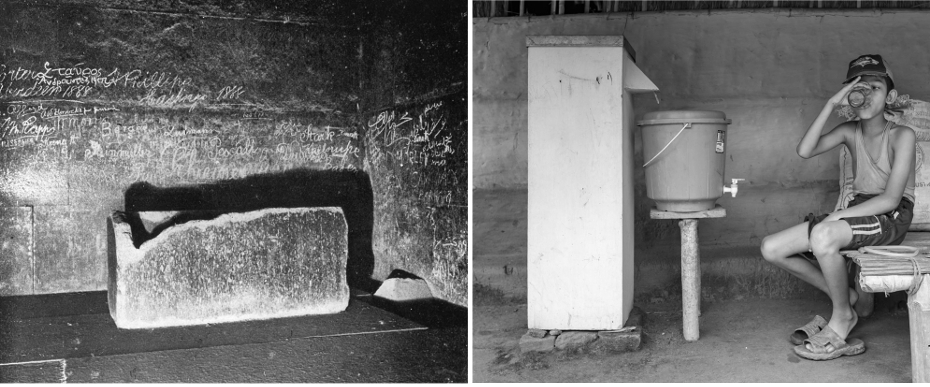
The sarcophagus was a biosand filter (discontinuous) or biologic slow sand filtration (continuous) for drinkable water supply
Though the sarcophagus had been found in the King's chamber, it had really been used (most probably for months), as a slow biosand filter for drinkable water supply from the King's chamber that was a water tank. The sarcophagus was installed in the little service room just next to the antechamber (not accessible to public). Please, observe on the drawing below, how the north water supply duct has been bended to get to the sarcophagus before getting to the King's chamber.
Also, the pit inside the King's chamber was a water reserve in case of the chamber might get dry. It was a well : the sand filtration works with living bacteria, and they need to be constantly under water to survive. Otherwise, all the process of getting the filter back in track would take a full month period. The time necessary to get a new bacteria population strong enough to get drinkable water.
For the shutdown of the pyramid, the sarcophagus had to be moved in order to hide or destroy all the area around it, in particular the portcullis system and the limestone blocks around, that controlled the water flow getting in and the King's chamber shaft. The first thing to do was to empty all the sand and the coarse gravel it contained (around 0.78 m³) and it was probably thrown out directly into the grand gallery or onto the top platform.
Most of this material from the sarcophagus, and from the digging done around it and from other digging places that occurred during the shutdown procedure, ended up inside the horizontal passage , the Queen's chamber and the lower parts of the Queen's chamber shafts after the "explosive" opening of the King's chamber complex.
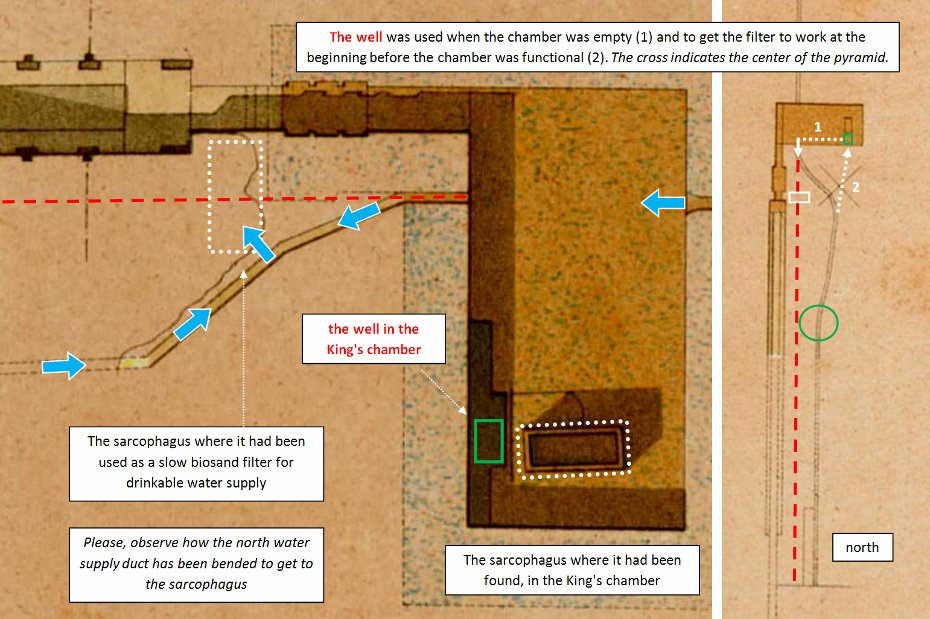
The granite sarcophagus in the Great Pyramid of Khufu at Giza was a bio-sand filter for drinkable water supply.
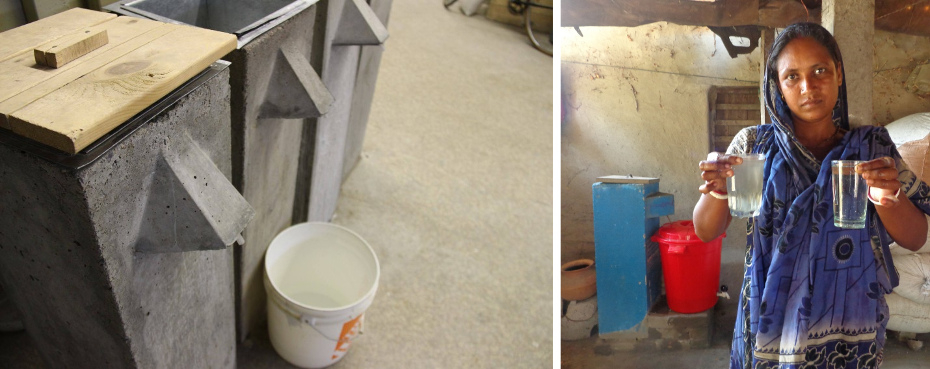

The equipment inside the grand gallery
A wooden gantry, that I call "the beetle", was operated by 10 men on the ramps. 8 were inside the beetle and 2 were "flying crewmembers", operating behind the beetle progression (these men were in charge of forcing the latch-bolts inside the walls after the passage of the beetle, and they were responsible for inserting the security pins inside the long mortises when the beetle was lifted up).
More details about the beetle on the scarab amulet post, here
The crew members had to go down the grand gallery backwards, because this is in this position that you can deliver the most effective effort, using at full power your legs and your back against the backrest.
The wooden rails of the grand gallery
The "beetle" wooden gantry was constantly moving up and down in the grand gallery on water lubricated wooden rails, one for each ramp. These rails were made of the assembly of identical units of 3.198 cubits.
1 cubit = 0.5236 meter, or 52.36 centimeters.
Every single rail unit ends up with tenons that will be inserted in the floor mortises.
There were short mortises on the floor of the 2 ramps (1 cubit long) and large mortises as well (1.13 cubits)
Every mortise was fit for tenons of 2 different rail units.
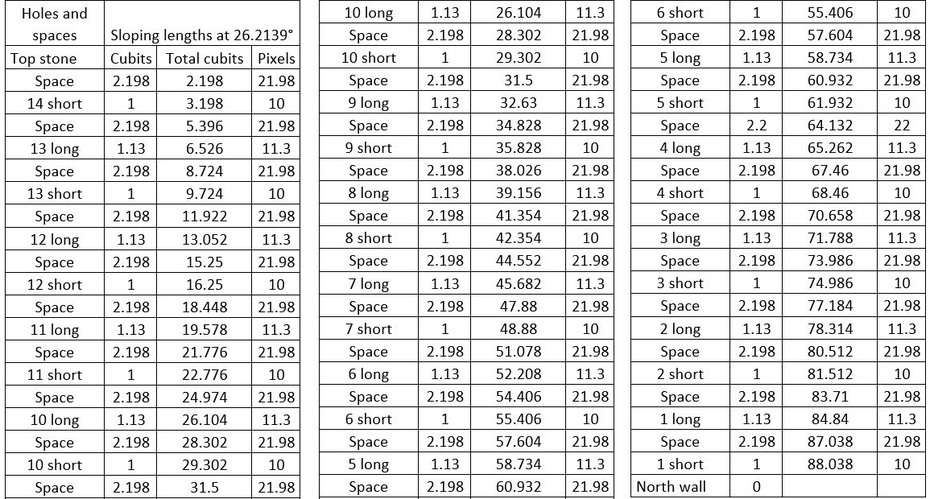
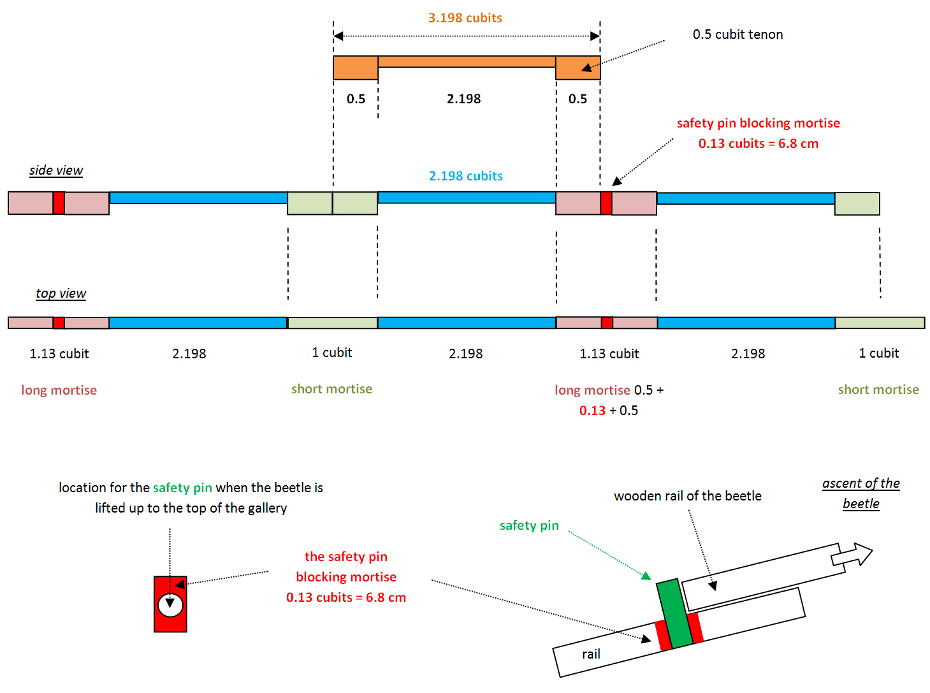
The beetle operating procedure in the grand gallery.
1/ The beetle is on top of the grand gallery. The 2 ropes it is attached to are 100% rolled up around the winding beam and the piston is simply floating inside the well, its rope 100% unrolled and resting on the wooden floor of the platform at the top of the gallery.
2/ We need to get the piston back. So the first thing to do, is to drop its unrolled rope, inside the fixed casing. Now, we can reattach the end of the rope to the piston.
3/ The 10 men crew can then start to move the beetle down the gallery. The descent of the beetle allowed to raise the moving piston up to the top of the grand gallery, in 25 very demanding steps. They were going backwards, because this is in that position that you can deliver maximum pulling force, using your legs and your back. Every step was secured by 2 latch-bolts, one on each ramp, that were inserted inside the wall niches (2 x 25 niches, 50 niches total).
The latch-bolt is what you have on every single door you have at home. With this latch-bolt, you can slam the door closed just by pushing it, and it won't move again, unless you move the handle down. The 2 crewmembers at the top of the beetle were certainly the most experienced and were working with their eyes permanently turned to the latches, checking that it would correctly pop-up again once it had been pushed inside the wall by the passage of the beetle's slider.
4/ As the beetle is moving down the gallery, its 2 ropes unwind from the beam and the piston's rope winds up at the same time.
5/ The beetle is now secured at the bottom of the gallery by the last latch-bolt. Its ropes 100% unrolled on the ramp. The piston is secured at the top of the gallery, its rope is 100% rolled up on the beam.
6/ At the bottom of the gallery, a blocking slab shim is inserted between the beetle and the wall and it can now be released from the last latch-bolt.
7/ Before the release of the piston, the beetle first needs to be pushed up at the top of the gallery by
4 men, using the transversal beams of the beetle (2 on each side). 2 other men stay behind the beetle and secure the climbing with the safety pins they insert inside de safety mortises. 2 other men pull the ropes of the ramps from the top platform (1 on each side) and these 2 ropes then wind up automatically when the last 2 men of the crew unroll the piston rope on the wooden floor of the platform. The climbing of the beetle though, wasn't very challenging (there was nothing else to lift than the gantry itself), so the safety precautions were limited to one out of two steps. And this is why we have the long mortises : every two steps, a safety pin of 6.8 centimeters had to be inserted in it.
Of course, in order to push the beetle up to the top of the gallery, the latch-bolts had to be forced inside the wall. This could be done manually but I would say it was certainly fully automatic. Probably, the groove that had been made that runs through the entire gallery, was implicated in that process of forcing the latch-bolts inside the walls, and then back again out of the wall, ready for the next operating cycle.
8/ Both the beetle and the piston are now secured on top of the grand gallery. The beetle ropes are rolled around the beam. The piston rope is neatly resting on the floor.
9/ Everything is ready for the next cycle, the piston can now be unhooked from its rope and ready to be released.

When the piston is released in the gutter of the grand gallery and ends-up at the bottom of it, this central rope had to be pushed inside the fixed caisson so that it could be attached to the piston. This rope is pretty much constantly in contact with the water that is circulating inside the caisson for the lubrication of the glide, and is constantly wet. So, when it is put on the wooden floor of the platform, waiting to be pushed back in the caisson, it is dripping water all over the floor. And this is why the top stone of the floor had been adapted to collect this water and redirect it to the gutter. The collector didn't have to be pretty, because it was hidden by a perforated wooden floor.
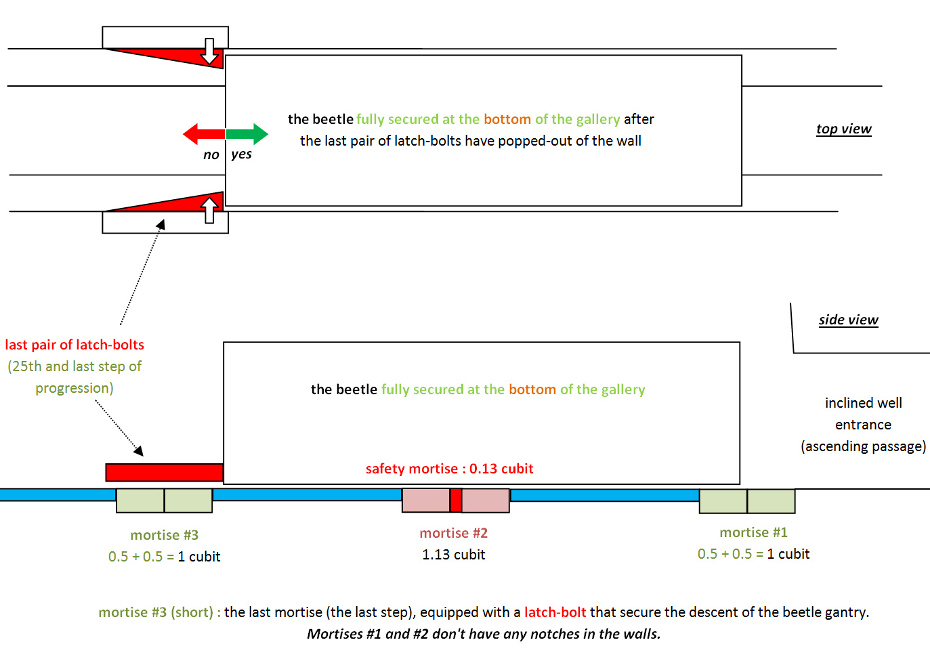
The antechamber : a ventilated storage room for the 3 ropes of the grand gallery
This room was providing 3 drying and storage separated racks with 4 aeration pipes coming from the south grooved wall and the floor.

Photograph on the left : the 4 grooves south wall of the King's antechamber of the Great Pyramid of Khufu at Giza. Please notice that all the chamber is built with massive granite blocks, but surprisingly the top of this south wall is made of very worn out low-quality limestone. This limestone had been added after the pyramid shut-down, when this chamber didn't need to be connected to the exterior anymore.

If the elevation stopped at the top part of the Queen's chamber shafts, it also explains the grooves found in the Lady's Arbuthnot's chamber : they were the extensions of the grooves in the antechamber south wall. Inside these grooves were installed 4 air pipes for the ventilation of the antechamber. That ventilation was necessary to dry out the 3 ropes after being used in the grand gallery.
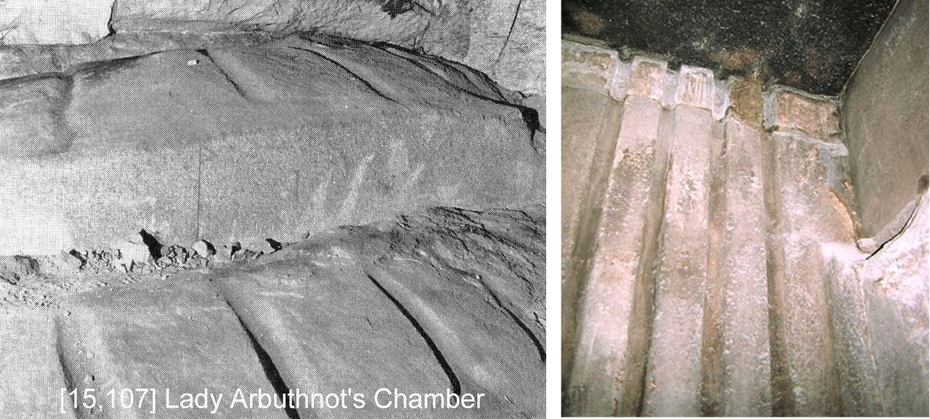
The 4 air pipes that were inserted inside the 4 grooves of the antechamber's south wall, were extended towards the Lady Arbuthnot's chamber. From this chamber, the pipes were connected to the exterior of the pyramid, passing through limestone blocks that have been replaced at the shut-down of the pyramid. Under this Arbuthnot's chamber, every block of the King's chamber complex is made of granite. Starting with this Arbuthnot's chamber, the granite blocks supporting the granite beams are replaced by limestone blocks.
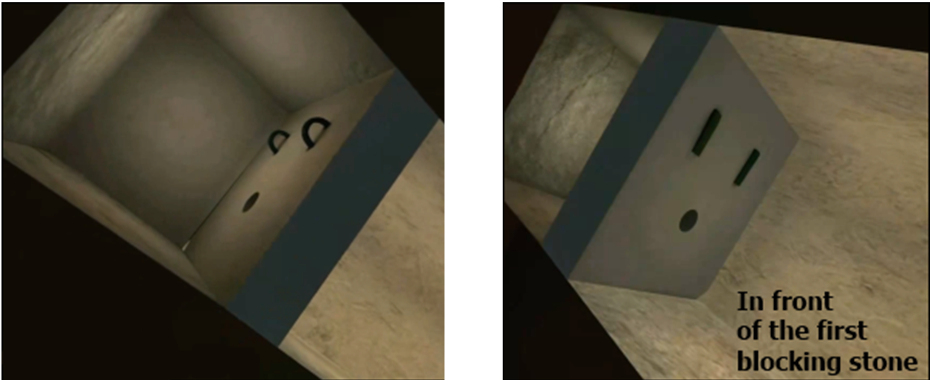
The Queen's chamber and the copper serpentine cold exchanger
The Queen's chamber wasn't on the center line of the pyramid by accident. All the efforts invested by the grand gallery crew ended up in this chamber. Like every place in the above ground pyramid, it was (probably) covered in wooden casing that made the basin waterproof and the chamber completely thermo-isolated to keep the cold from getting out.
The Queen's chamber was designed to be a cold accumulator to cool down chemical reaction towers installed on the flat roof of the pyramid, for the manufacturing of sodium carbonate Na2CO3, the purest form of natron, by a Solvay-like process. Inside the chamber, a serpentine cold exchanger was set and might have filled the whole chamber. The serpentine was made of copper, and was connected to the Solvay towers by the 2 shafts of the chamber.
We can still see today at the back of the 2 first blocking slab stones at the upper part of both shafts, parts of these copper pipes.
On the front of these first blocking slabs, we see today that the pipes have been cut off and very neatly hammered down against the slabs and then flattened. These hammered pipes are called today "copper pins". We know it is copper (or mostly copper) because of the greenish coloration of it, resulting of the very hot and humid atmosphere conditions before the installation of the ventilation system in the pyramid.
But then, there is a problem. Because if the pipes inside the shafts have been neatly cut off, hammered down and flattened, only for the shutdown procedure, it means that the construction of the pyramid stopped pretty much on that level and stayed at that level during all the operation of the pyramid.
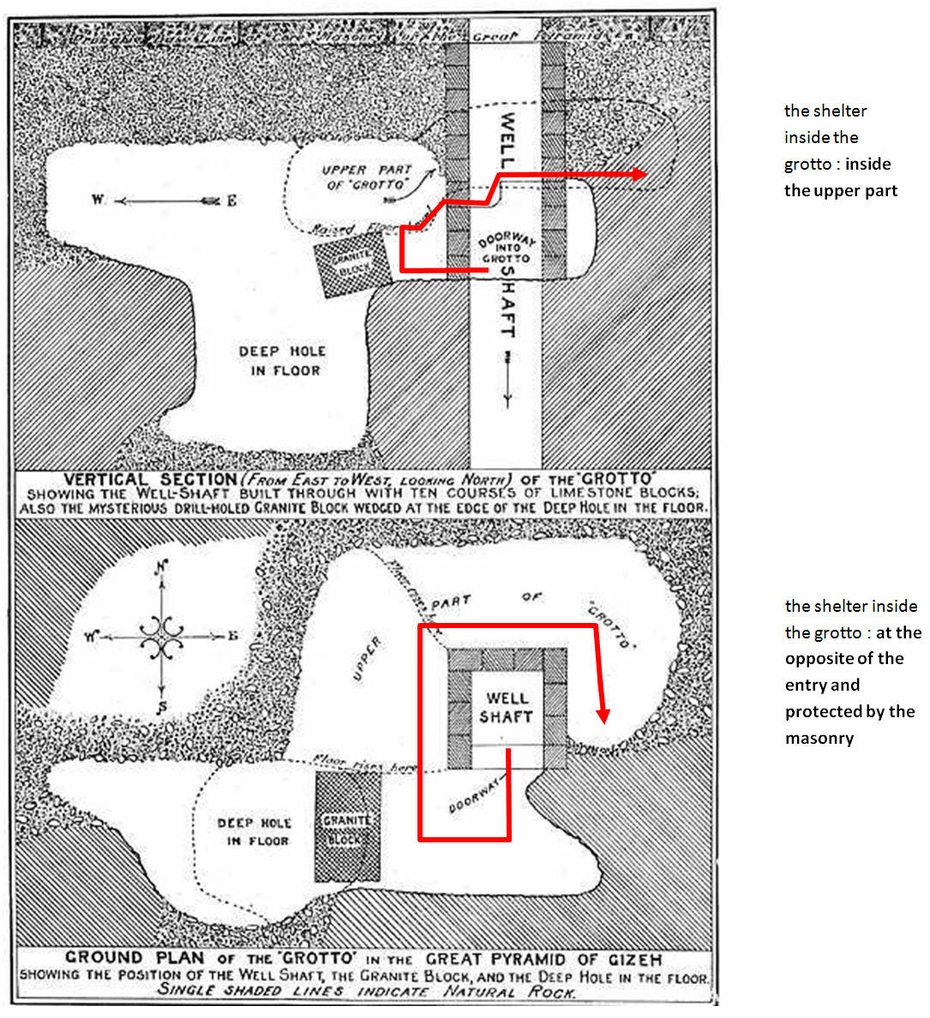
"Great Pyramid Passages, Volume 1, by John and Morton Edgar 1910" page 276 : https://archive.org/details/GreatPyramidPassagesVol11910Edition/page/n285/mode/2up
The shelter in the grotto
This Great Pyramid grotto thing reminds me of the Geb, Shu and Nut scene, where nothing can be understood without having water in mind.
Nut cannot be understood without water, as the similarity with Tefnut's name ('tf'= to spit and 'nwt'=water) and the water pot emblem of Nut can suggest.
The exact same way, to understand the design of the grotto, you do need to add water.
More precisely, the grotto has been designed fearing water : the grotto is a shelter from water coming down the vertical well shaft.
This is the reason why there is a deep hole in the floor to accumulate the water and preserve the upper part of the grotto.
This upper part has another particular design : its end part has been set the further away to the doorway as possible ; the doorway East wall protecting the very last end of this upper part.
This is a perfect design of a shelter, the further away from the doorway in an elevated section with a protective retention basin at the entrance.
The reason of the shelter
This shelter indicates that water was supposed to come through the well shaft ; so now there is another problem : where did the water could have come from?
I see 3 possibilities : the King's chamber main water tank, the Davison chamber and both chambers.
The draining of the inclined well
In my opinion, the opening of the dormant breach was done by releasing the impactor one last time, without the wooden part that served as a float for its recovery from the well after the impacts, cycle after cycle.
The last voyage of the impactor was most probably done using only the granite weight (most probably the one found in the recess of the subterranean chamber) and it somehow triggered the opening of the breach by breaking a small granite stone that was set inside the little imprint, precisely between G8 and G9. If I remember correctly, this little imprint is still filled today with the lower part of that small granite "chock block".

The construction of the pyramid without any ramp
This is a different approach of the way that the pyramid could have been constructed. I've never been fond of the ramp idea, because it takes time and a lot of efforts and material. Moving stones, even huge stones, is not something difficult at all. Every civilization in the world did use and moved huge stones when the stone technology was the more advanced of all. And none of them did need to build a pyramid to do it.
Moving or elevating huge stones, everybody can do it. I can do it, you can certainly do it. It is a just a matter of skills, not force. You can see on the internet a video (I'm sure many of videos exist, but one is enough for me), where a single guy, all by himself, 40 or 50 years old and a little overweighed, can move up a concrete block of maybe 10.000 kilos with only 2 beams and 2 buckets (water or sand, but it doesn't matter). And he elevated the block 2 or 3 meters high, without any sweat at all, just walking on the block with his 2 buckets !
Of course, there is a trick : each time he gets to one end of the block he has to come down and slide a beam the closest he can to the center of gravity of the block. This way he is elevating the block, step by step, pretty much like with a car jack.
So if this guy, alone in his backyard can do this, I'm not going to try to imagine something more complicated, like a grand gallery or whatever, to move blocks.
My idea is to use oscillating lifts, that actually do exactly the same thing that what that guy did, but better and faster because in a continuous way. It is constantly oscillating around the center of gravity of the block instead of a series of stop and go.
This method is very simple and effective to lift the blocks, but it is also a beautiful way to deal with the logistics. The blocks can be pre-positioned all around the pyramid on multiple layers, ready to be taking care of. By using this method, you can take advantage of the entire surface of the pyramid. The scale of the pyramid isn't a problem at all if you just have the manpower.
If we imagine that 4 crew members were operating a oscillating lift, we can start doing some calculations.
1/ 135 million lifts needed
We need to take care of 2.7 millions blocks. The pyramid is 200 stone courses, let's say it is a full cube of 100 courses : every block had to be lifted 50 courses in average. That is 135 millions lifts for the construction of the pyramid.
2/ 6100 oscillating lifts working at the same time
Let's say that an oscillating lift needs 4 crewmembers and 7.5 meters to work. The perimeter of the pyramid is 230 x 4 = 920 meters, so the average perimeter available is half of it : 460 meters. On these 460 meters we can fit 460 / 7.5 = 61 oscillating lifts. So for our hypothetical cube, we can have 61 x 100 courses = 6100 oscillating lifts working at the same time with 6100 x 4 = 24.400 workers.
3/ 15 to 20 years to build the pyramid
Lets say that every crew could lift a stone 3 times a day, that is 6100 x 3 = 18.300 lifts. If we need 135 million lifts, that would take 135 million / 18.300 = 7377 days for the lift of all the stones of the pyramid. 7377 days, that is 20.2 years.
Of course, if we need less than 7.5 meters for each lift or if we can lift a stone 4 times a day instead of 3, we won't need 20 years but closer to 15 years.

THE DENDERA LIGHT : the Dendera "Light Bulb" is the microdroplets fog of the Great Pyramid
Amazingly, the proof of pretty much every part of my theory, is carved in the Dendera Light Bulb reliefs : the fog of microdroplets produced inside the horizontal passage of the Great Pyramid, is the Dendera Light. The snake represented inside the Dendera Light Bulb explains how was produced the fog of microdroplets : the same way a spitting snake does when protecting itself with its venom.
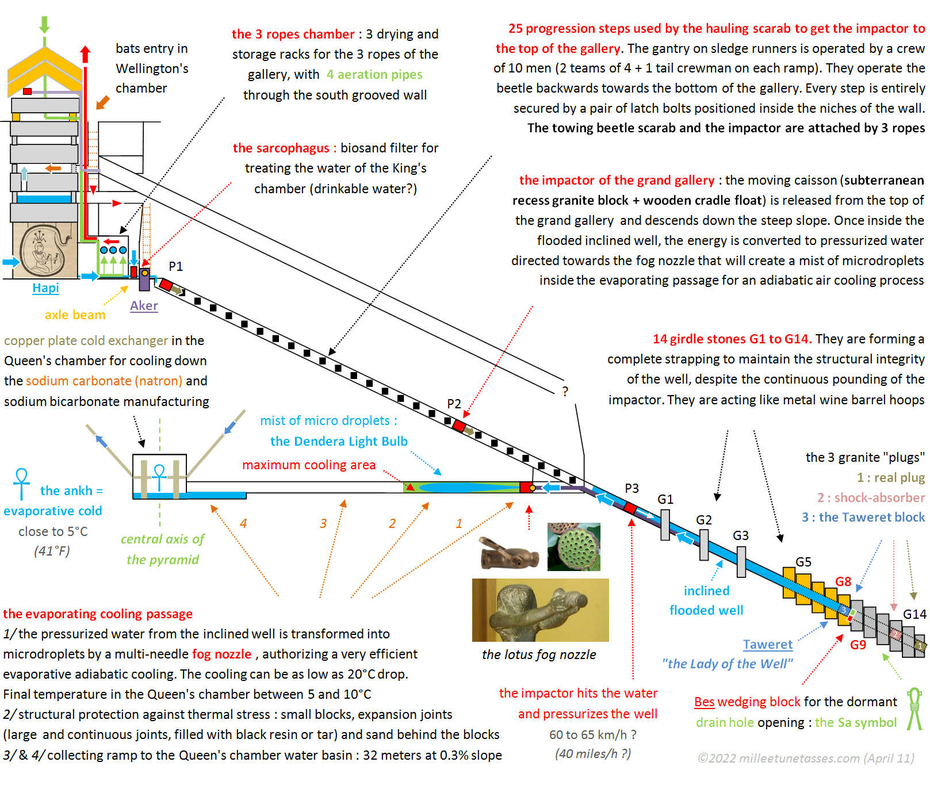
0.01 The Pyramids of the Cold - Very quick abstract of the study
Ancient Egyptian pharaohs used chemistry and physics to legitimate themselves as kings of Egypt, and they forged an entire religion for that matter : gods were self-glorification metaphors of their scientific accomplishments. The end game of this technological program was the Great Pyramid of Giza where evaporative cooling was engineered in the known part of the pyramid, using the power of water, most probably as suggested by the strong ammonia smell in the Red Pyramid, to cool down chemical manufacturing of sodium carbonate and sodium bicarbonate. At that time, sodium carbonate was called natron, and it was the salt used for the mummification of the pharaohs.
Ancient Egyptians were the first civilization to master a Solvay-like process for sodium carbonate manufacturing, long before it got reinvented in the 1800's in Europe. The key elements of that process is the temperature control of the chemical reactions (the cooling), and the dome shaped plate necessary for the counterflow chemical reactions to occur in an efficient way, and that plate is precisely what is the disc of Sabu.
If mastering the Solvay-process was important, it actually looks like the cold was the most magical phenomenon worshiped by ancient Egyptians, as suggested by Akhenaten and Nefertiti who represented themselves as Shu and Tefnut, the deities that combined together were creating the evaporative cold (Shu = dry warm air, and Tefnut = spat water).
The evaporative cold is what represents the ankh symbol that is given by Akhenaten to the heat of the Sunbeams.
Also, the very first pyramid complex, the Step Pyramid of Djoser, was called "the refreshment of the Gods".
0.02 The Pyramids of the Cold - Table of contents
Section 1 • The Evaporative Cooling Passage, Nefertem and the khepeshes
Section 2 • The Evaporative Cooling : the Dendera Light
Section 3 • The Evaporative Cooling : the Heka, Geb, Shu, Nut and Tefnut glorifying metaphors
Section 4 • The Inclined Well layout : the Girdle Stones and the interlocked blocks
Section 5 • The Inclined Well waters : the Apep metaphor of the pressurized waters
Section 6 • The Inclined Well : the Taweret Lady of the Well block
Section 7 • The Inclined Well : the Bes wedging block
Section 8 • The Inclined Well : the draining of the well
Section 9 • The Inclined Well : the Was Scepter, the Sa Symbol and the Isis Knot
Section 10 • The Impactor
Section 11 • The Grand Gallery : the Hidden Hauling Cavern of the Underworld
Section 12 • The Grand Gallery : the Hauling Beetle designed for 8+2 crewmembers
Section 13 • The Grand Gallery : the Scarab Amulets
Section 14 • Solvay process (natron manufacturing) : the Red Pyramid
Section 15 • Solvay process (natron manufacturing) : the Disc of Sabu
Section 16 • Solvay process : the cooling of the Eye of Horus
Section 17 • The Ankh symbol and the changes made by Akhenaten & Nefertiti
Section 18 • The Sarcophagus of the Great Pyramid
Poster un commentaire

